Dynabook UMET401WL Portable media player User Manual 13 Toshiba MET401
Toshiba Corporation Portable media player 13 Toshiba MET401
Dynabook >
User manual
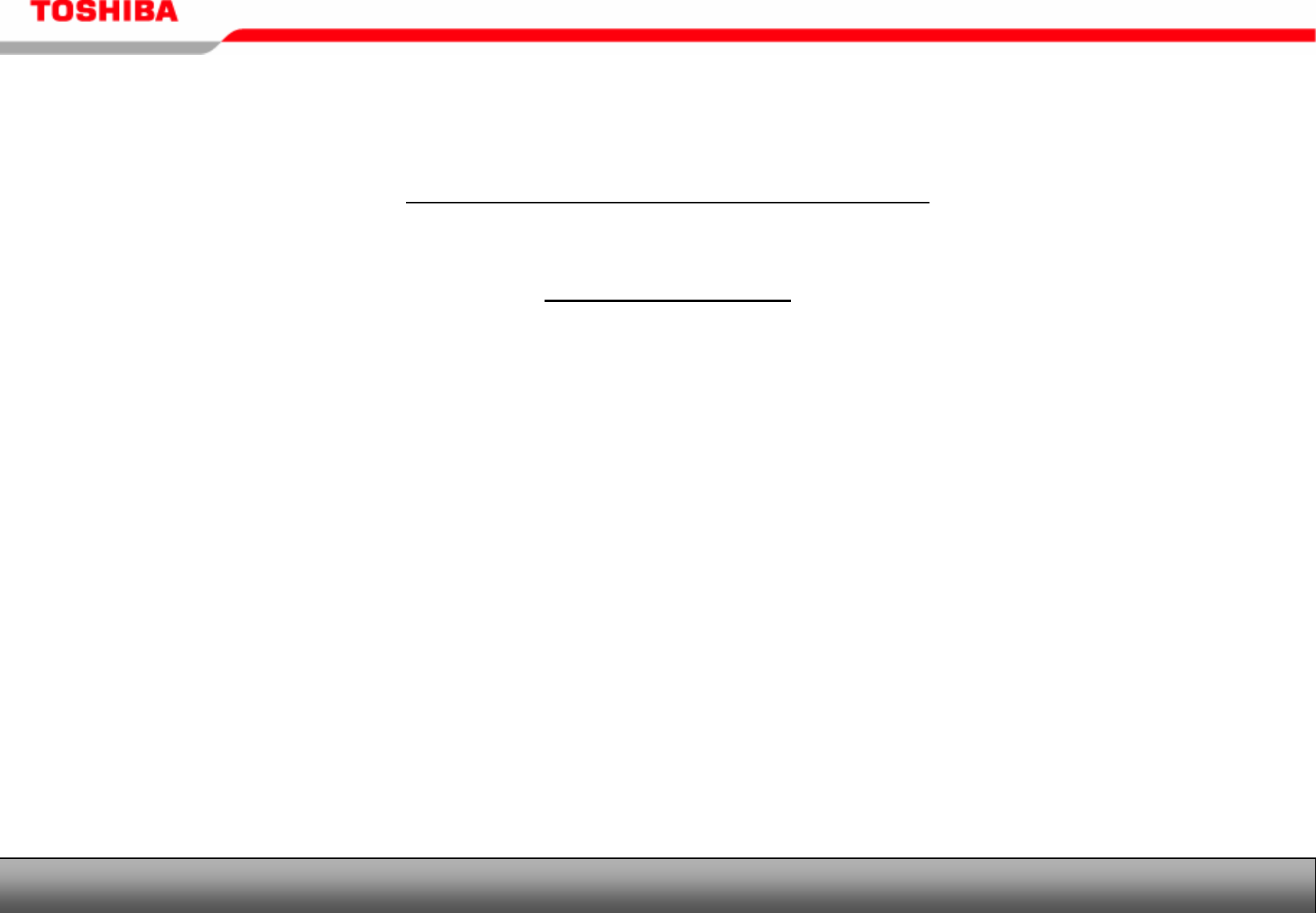
CONFIDENTIAL INFORMATION
Page-1
Portable Media Player MET401
User’s Manual
Rev. 0.9 (Draft)
TOSHIBA CORPORATION
Digital Media Network Company
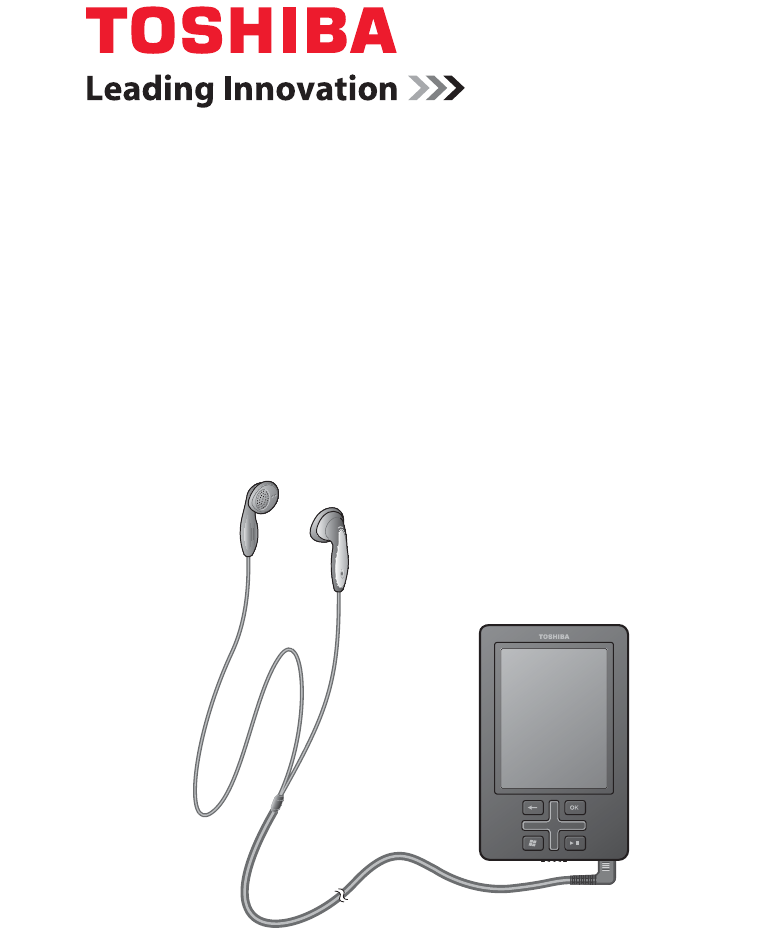
GMAD00139010
07/07
Toshiba Portable Media Player
gigabeat® T Series
User’s Guide

2
Model: gigabeat® T Series
Handling the cord on this product will expose you to lead, a
chemical known to the State of California to cause birth defects or
other reproductive harm. Wash hands after handling.
FCC notice “Declaration of Conformity Information”
This equipment has been tested and found to comply with the limits
for a Class B digital device, pursuant to Part 15 of the FCC rules.
These limits are designed to provide reasonable protection against
harmful interference in a residential installation. This equipment
generates, uses and can radiate radio frequency energy and, if not
installed and used in accordance with the instructions, it may cause
harmful interference to radio communications. However, there is no
guarantee that interference will not occur in a particular installation.
If this equipment does cause harmful interference to radio or
television reception, which can be determined by turning the
equipment off and on, the user is encouraged to try to correct the
interference by one or more of the following measures:
❖Reorient or relocate the receiving antenna.
❖Increase the separation between the equipment and receiver.
❖Connect the equipment into an outlet on a circuit different from
that to which the receiver is connected.
❖Consult the dealer or an experienced radio/TV technician for
help.
Only peripherals complying with the FCC rules class B limits may be
attached to this equipment. Operation with non-compliant
peripherals or peripherals not recommended by TOSHIBA is likely to
result in interference to radio and TV reception.Shielded cables must
be used between the external devices and USB connector. Changes
or modifications made to this equipment, not expressly approved by
TOSHIBA or parties authorized by TOSHIBA could void the user’s
authority to operate the equipment.

3
FCC conditions
This device complies with Part 15 of the FCC Rules. Operation is
subject to the following two conditions:
1This device may not cause harmful interference.
2This device must accept any interference received, including
interference that may cause undesired operation.
Contact Address:
TOSHIBA America Information Systems, Inc.
9740 Irvine Boulevard
Irvine, California 92618-1697
(949) 583-3000
Industry Canada Requirement
This Class B digital apparatus complies with Canadian ICES-003.
Cet appareil numèrique de la classe B est conforme à la norme
NMB-003 du Canada.
FCC Radiation Exposure Statement:
This transmitter complies with the FCC radiation exposure limits as
set forth for the general population/uncontrolled environment. To
comply, or maintain compliance, with the FCC RF exposure
requirements, no change to the antenna or the device is permitted.
Any changes to the antenna or the device could result in the device
exceeding the RF exposure requirements and would void user
authorization to operate the equipment. In addition, this transmitter
must not be co-located or operating in conjunction with any other
antenna or transmitter.
VCCI
This is a Class B product based on the standard of the Voluntary
Control Council for Interference from Information Technology
Equipment (VCCI). If this is used near a radio or television receiver
in a domestic environment, it may cause radio interference. Install
and use the equipment according to the instruction manual.
Safety Information
Important information you must know in order to use the gigabeat®
correctly to prevent injury to yourself or others, or damage to
property is provided in the Safety Instruction Guide located on the
software and documentation CD shipped with your unit.

4
Notice
The information contained in this manual, including but not limited
to any product specifications, is subject to change without notice.
TOSHIBA CORPORATION AND TOSHIBA AMERICA
INFORMATION SYSTEMS, INC. (TOSHIBA) PROVIDES NO
WARRANTY WITH REGARD TO THIS MANUAL OR ANY
OTHER INFORMATION CONTAINED HEREIN AND HEREBY
EXPRESSLY DISCLAIMS ANY IMPLIED WARRANTIES OF
MERCHANTABILITY OR FITNESS FOR ANY PARTICULAR
PURPOSE WITH REGARD TO ANY OF THE FOREGOING.
TOSHIBA ASSUMES NO LIABILITY FOR ANY DAMAGES
INCURRED DIRECTLY OR INDIRECTLY FROM ANY
TECHNICAL OR TYPOGRAPHICAL ERRORS OR OMISSIONS
CONTAINED HEREIN OR FOR DISCREPANCIES BETWEEN
THE PRODUCT AND THE MANUAL. IN NO EVENT SHALL
TOSHIBA BE LIABLE FOR ANY INCIDENTAL,
CONSEQUENTIAL, SPECIAL, OR EXEMPLARY DAMAGES,
WHETHER BASED ON TORT, CONTRACT OR OTHERWISE,
ARISING OUT OF OR IN CONNECTION WITH THIS MANUAL
OR ANY OTHER INFORMATION CONTAINED HEREIN OR THE
USE THEREOF.
Trademarks
❖gigabeat is a registered trademark of TOSHIBA Corporation.
❖Microsoft, Windows, Windows logo, Windows Vista, Windows
Vista logo, Windows Media and Windows Media logo are
registered trademarks or trademarks of Microsoft Corporation
in the United States and other countries.
❖Adobe, Adobe logo and Reader are trademarks or registered
trademarks of Adobe Systems Incorporated in the United
States and other countries.
❖Macintosh is a registered trademark of Apple Computer, Inc.
❖All other brand and product names are trademarks or registered
trademarks of their respective companies.
Copyrights
❖The data you have recorded must be used for your own
personal enjoyment. They are protected by the copyright laws
and cannot be used for any other purpose without a prior
permission from their copyright holders.
❖The unauthorized recording, use, distribution, or revision of
television programs, videotapes, audio cassettes and CDs,

5
DVDs and other materials, is prohibited under the Copyright
Laws of the United States and other countries, and may subject
you to civil and/or criminal liability.
❖You must obtain any required permission from copyright
owners to download or use copyrighted content. Toshiba
cannot and does not grant such permission, nor does Toshiba
authorize the use or reproduction of copyright material without
the relevant permissions being obtained from copyright
holders.
❖This product incorporates copyright protection technology that
is protected by method claims of certain U.S. patents and other
intellectual property rights owned by Macrovision Corporation
and other rights owners. Use of this copyright protection
technology must be authorized by Macrovision Corporation,
and is intended for home and other limited viewing uses only
unless otherwise authorized by Macrovision Corporation.
Reverse engineering or disassembly is prohibited.
❖This computer program is protected by U.S. and international
copyright laws. Contains security software licensed from RSA
Data Security, Inc. Portions of this software are based in part
on the work of the Independent JPEG Group.
❖This guide is copyrighted by Toshiba America Information
Systems, Inc. and/or Toshiba Corporation with all rights
reserved. Under the copyright laws, this guide cannot be
reproduced in any form without the prior written permission of
Toshiba. No patent liability is assumed, however, with respect
to the use of the information contained herein.
❖©2007 by Toshiba America Information Systems, Inc. and/or
Toshiba Corporation All rights reserved.
❖This product is protected under the laws and international
treaties on copyrights.
About Data
❖TOSHIBA shall assume no responsibility for any damage or
loss of audio data or other data due to a problem in the product
or your computer.
Electromagnetic Interference with Radio, TV, Etc.
This equipment is classified as a Class B information technology
device conforming to the standards set forth by the Voluntary
Control Council for Interference by Information Technology
Equipment (VCCI). The equipment is designed for use in a home

6
environment, but using it too close to a radio or television set, may
result in poor reception. Handle the equipment correctly according
to this owner's manual.
About This Product
❖This product incorporates a copyright protection technology
protected by the U.S. patents and other intellectual properties
owned by Macrovision Corporation and other rights holders.
Use of this copyright protection technology requires an express
permission from Macrovision Corporation. Without permission
from Macrovision Corporation, the product can only be used to
listen to or view audio and video data in a general home
environment and other limited situations. Modification or
disassembly of the product is strictly prohibited.
❖This product is protected under the laws and international
treaties on copyrights.
The product incorporates security software licensed from RSA
Data Security, Inc. A part of this software uses technology
provided by the Independent JPEG Group.
❖This product uses the Windows Media DRM10 technology and
is protected by certain intellectual properties owned by
Microsoft Corporation and multiple third parties. Use or
distribution of any such technology for any purpose not
associated with this product is strictly prohibited, unless a
license is obtained from Microsoft, its subsidiary or a third
party having the rights to the applicable technology.

7
Contents
Introduction................................................................................ 12
Checking the supplied accessories .........................12
Safety icons ............................................................13
Safety precautions .................................................13
Caring for your gigabeat®.................................13
Recommendation for deleting data before
disposal/transfer ........................................14
Built-in battery .................................................14
Chapter 1: Getting Started with Your gigabeat®...................... 15
Computer system requirements1......................16
Installing the software.............................................16
Charging the built-in battery .............................17
Charging the gigabeat®.....................................18
Additional information ......................................18
Turning ON/OFF the power ...............................19
Connecting your computer and the gigabeat®...20
Removing the gigabeat® from your computer...22
Basic gigabeat® operations .....................................23
Names and functions of gigabeat® buttons ......23

8Contents
Chapter 2: Music and Your gigabeat®...................................... 27
Preparing music data .............................................27
Loading songs from a music CD to your
computer ....................................................27
Transferring audio files on your computer
to the gigabeat®..........................................29
Synchronization settings (Windows Media®
Player 11) ..................................................33
Transferring an album jacket photo .................34
Listening to music .................................................35
Listening to selected music .............................35
Playback screens ...................................................39
Elapsed time or remaining time .......................39
Playback-screen selection screen ....................40
Track list screen ...............................................41
Music setting screen ........................................41
Functions available during playback........................42
Adjusting the volume .......................................42
Pausing ............................................................42
Returning to the beginning of a song or skipping
to the previous or next song ......................43
Fast rewinding/forwarding ................................43
Displaying the start screen ...............................43
Listening repeatedly/changing the play sequence ..43
Listening repeatedly..........................................43
Changing the play sequence .............................44
Changing the sound quality ...................................45
Changing the equalizer .....................................45
Setting/changing the harmonics function ........47
Listening to music using a playlist .........................48
Creating a quicklist ..........................................48
Deleting data from a quicklist ..........................49
Playing a playlist ..............................................51
Managing music data .............................................52
Rating music data ............................................52

9
Contents
Deleting music data .........................................53
Chapter 3: Photos and your gigabeat®..................................... 54
Transferring photos to the gigabeat®......................54
Retrieving photo data from a digital camera ..........57
Deleting photo data ..........................................58
Reserving a storage space .....................................61
Viewing photos ......................................................63
Viewing photos by folder .................................63
Viewing photos by date ....................................64
Changing photos ....................................................65
Zooming in........................................................66
Changing the orientation ..................................67
Showing photo information and music
information ......................................................68
Viewing a slide show .............................................69
Playing a slide show ........................................69
Stopping the slide show ...................................71
Changing the slide show interval .....................71
Play a random slide show .................................72
Deleting photos ......................................................73
Chapter 4: Video and your gigabeat®....................................... 74
Transferring video data ....................................74
Viewing video .........................................................78
Playing selected video data ..............................78
Functions available during playback .......................79
Adjusting the volume .......................................79
Pausing ............................................................79
Resuming the playback/playing from the
beginning....................................................80
Fast rewinding/forwarding ................................80
Displaying the start screen ...............................81
Changing the orientation ..................................81
Deleting video data ................................................82

10 Contents
Chapter 5: TV and your gigabeat®............................................ 84
Preparing TV program data ....................................84
Transferring recorded TV programs .................84
Viewing recorded TV programs ..............................85
Playing a selected TV program ........................85
Functions available during playback .................86
Chapter 6: Podcasts and your gigabeat®................................. 87
About the Wireless LAN function ...........................87
Notes on security when Wireless LAN
products are used ......................................87
Setting up a Wireless LAN connection ...................88
Connection example..........................................89
Preparation ......................................................89
How to enter from the keyboard screen............91
Deleting a registered access point ...................91
Modifying a registered access point..................92
Keeping the Wireless LAN power always on ....92
Registering a podcast site ................................93
Deleting a registered podcast site .....................93
Downloading podcast content ..........................94
Updating the content list of a podcast site ........95
Playing podcast content .........................................95
Chapter 7: gigabeat® Settings................................................... 96
Changing the gigabeat® display .............................96
Setting the backlight off time ...........................96
Changing the screen brightness........................99
Adding effects ................................................100
Setting a language/region ..............................101
Changing the operation settings ..........................104
Using sound effects .......................................104
Changing the scroll speed...............................105
Initializing the settings ...................................106
Checking the gigabeat® information................107
Menu list ..............................................................109

11
Contents
Chapter 8: If you have problems ............................................ 113
Error messages.....................................................113
Troubleshooting....................................................114
Resetting the gigabeat®........................................115
Frequently asked questions ..................................116
Contacting Toshiba ...............................................116
Appendix A: Specifications...................................................... 117
Combinations of sampling frequencies and
bit rates ..........................................................119
Glossary.................................................................................... 121
Index.......................................................................................... 123
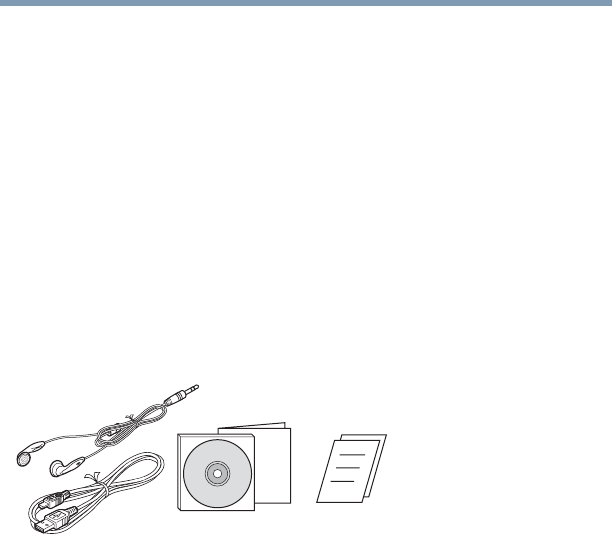
12
Introduction
Welcome to the world of portable entertainment. With your Toshiba
gigabeat® portable media player, your entertainment can
accompany you wherever you go.
This product is protected by certain intellectual property rights of
Microsoft Corporation. Use or distribution of such technology
outside of this product is prohibited without a license from
Microsoft® or an authorized Microsoft® subsidiary.
Checking the supplied accessories
The gigabeat® comes with the following additional items. If any
items are missing or damaged, please contact your dealer
immediately.
(Sample Illustration)
1
2345
1. Earbuds
2. USB cable
3. Software and Documentation
CD-ROM
4. Quick Start Guide
5. Legal Information
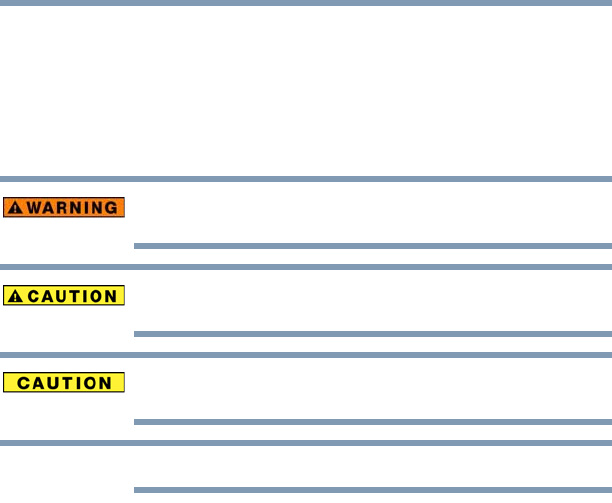
13
Introduction
Safety icons
Safety icons
This manual contains safety instructions that must be observed in
order to avoid potential hazards that could result in personal
injuries, damage to your equipment, or loss of data. These safety
cautions have been classified according to the seriousness of the
risk, and the icons highlight these instructions as follows:
Indicates a potentially hazardous situation which, if not avoided,
could result in death or serious injury.
Indicates a potentially hazardous situation which, if not avoided, may
result in minor or moderate injury.
Indicates a potentially hazardous situation which, if not avoided, may
result in property damage.
Provides important information.
Safety precautions
Important information you must know in order to use the gigabeat®
correctly to prevent injury to yourself, injury to others, or damage
to property is provided in the Safety Instruction Guide located on
the software and documentation CD shipped with your unit.
Caring for your gigabeat®
To clean the exterior, wipe it gently with a soft cloth.
❖Never use benzine, thinner and other organic solvents or
petroleum products, as they may cause discoloration of the
product surface.
❖If oil or an oil-based substance gets on the product, use a
diluted, weak neutral detergent solution and a soft cloth. Place
the cloth in the diluted solution, wring the cloth well, then soak
the cloth in warm water and wring it well again. Use the cloth
to wipe the soiled area thoroughly. Depending on the
substance, some surface discoloration may still occur even
when these instruction are followed.
❖Be particularly careful when cleaning the gigabeat® screen.
NOTE

14 Introduction
Safety precautions
❖The Toshiba gigabeat® T Series User's Guide (in PDF format)
can also be downloaded from the Toshiba website at
www.gigabeatsupport.toshiba.com. If you are unable to
download the User’s Guide, call 1-877-250-8595 or 1-949-
583-3212 for assistance.
❖This website also contains any upgrades of the application
software which may become available to enhance use after the
product has been shipped as well as information on purchasing
gigabeat® accessories.
Recommendation for deleting data before disposal/transfer
❖This gigabeat® contains built-in flash memory. When disposing
of or reselling your gigabeat®, please delete all of the data on
the flash memory. Otherwise, personal or private information
on the hard disk may be viewed by a third party. For details on
how to delete the data using the Format function, see PAGE
ADD REFERENCE .
Built-in battery
❖The built-in battery will gradually discharge, even when your
gigabeat® is not being used. If the gigabeat® is not used for a
prolonged period, the built-in battery may discharge
completely. If this should happen, charge the built-in battery
before using the gigabeat®.
❖The recharging time will vary depending on the condition of
the built-in battery, ambient temperature, and so on.
❖Using the gigabeat® at low temperatures will shorten the
continuous playback time.
❖The built-in battery is a consumable part. Repeated use will
gradually decrease the operating time. If the built-in battery is
consumed quickly after a full charge, the built-in battery may
have failed. Contact the gigabeat® Web site at
www.gigabeatsupport.toshiba.com for built-in battery
replacement information.
TOSHIBA shall not be liable whatsoever for any corruption or loss of
stored data due to the complete discharge of the built-in battery
NOTE
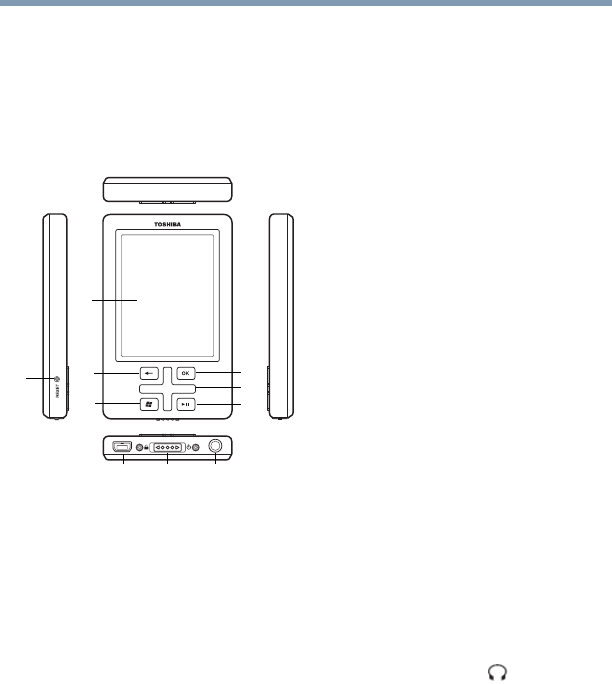
15
Chapter 1
Getting Started with Your
gigabeat®
Your gigabeat® will allow you to listen to music, watch videos,
download podcasts and transfer other audio and video content. This
chapter summarizes how to get you started using your gigabeat®.
The gigabeat® and it’s components are illustrated below.
1 Display screen (color LCD)
2 Enter button
3 Up/Down/Left/Right buttons
4 Play/Pause button
5 Back button
6 Start button
7 Reset switch
8 USB 2.0 connector
Plug the USB cable here to
connect to a computer.
9 Power/Lock switch
Slide the switch to the
ON/unlocked position to turn on
the power.
When the switch is in the
OFF/locked position, all operation
buttons are disabled. As a result,
unwanted operation can be
prevented.
10 Headphone jack ( )
1
2
3
4
5
6
7
8910

16 Getting Started with Your gigabeat®
Installing the software
Computer system requirements1
You need a computer system that meets the hardware and
software requirements listed below.
1. The gigabeat® may not operate on all computers. The gigabeat® does not
support Macintosh® systems.
2. To operate the gigabeat® in the USB 2.0 mode, a USB 2.0 interface must
be pre-installed on the computer. The gigabeat® functions as a USB 1.1
device when connected to a USB 1.1 interface.
Installing the software
You need Windows Media® Player 11 or 10 to connect your
gigabeat® to your computer to charge the gigabeat®, transfer music,
or transfer video and image data from your computer to the
gigabeat®.
If Windows Media® Player 11 is not yet installed on your computer,
please install it from the CD-ROM that came with your gigabeat®.
Please note that a computer pre-installed with Windows Vista®
software includes Windows Media® Player 11.
If your computer is using Windows Media® Player 10, a patch
program must be installed. You need to install Windows Media®
Player 10 from the CD-ROM again even if it is already installed.
This way, the necessary correction program will also be installed.
Operating
system
Microsoft® Windows Vista®, XP Home Edition, XP Professional or XP
Media Center Edition (Microsoft® Windows® XP: Service Pack 2 is
recommended.)
CPU Windows Vista®: 800 MHz or more (1.5 GHz or more is recommended.)
Windows® XP: 300 MHz or more (1.5 GHz or more is recommended.)
RAM Windows Vista®: 512 MB or more (1 GB or more is recommended.)
Windows® XP: 128 MB or more (512 MB or more is recommended.)
Hard disk
space
200 MB or more
Interface USB port (USB 2.0/1.1)2
CD-ROM
drive
Required for software installation
Software Windows Media® Player 11 or Windows Media® Player 10

17
Getting Started with Your gigabeat®
Installing the software
❖So that your gigabeat® can communicate with your computer
properly, be sure to install Windows Media® Player 11 or 10
on your computer before connecting the gigabeat® to your
computer.
❖To check if a newer bug-fixed module is available, it is
recommended that you run Windows Update on your
computer after installing the software.
1Insert the CD-ROM that came with your gigabeat® into your
computer.
The CD-ROM will be automatically recognized and the
installation menu for application software will appear. If this
menu is not displayed, double-click Lancher.exe on the CD-
ROM using Explorer.
2Click the Install Windows Media Player 10/11 button.
3Follow the on-screen instructions.
Depending on the OS of your computer, Windows Media®
Player 11 or Windows Media® Player 10 will be installed. (If
your computer is installed with Windows XP Service Pack 2 or
later, or Media Center Edition 2005 Rollup 2 or later, Windows
Media® Player 11 will be installed. If your Windows XP
Service Pack or Media Center is an earlier version, Windows
Media® Player 10 will be installed.)
To close the installation menu, click the Close button.
Charging the built-in battery
Connect your gigabeat® to your computer via the supplied USB
cable, and the gigabeat® built-in battery will automatically begin to
charge.
Charge the built-in battery sufficiently before using your gigabeat®
for the first time after the purchase, or when the gigabeat® is used
after a long period of non-operation.
Charging times vary depending on factors such as status of the
internal battery, ambient temperature, and performance of your
computer’s USB bus power supply.
Be sure to install Windows Media® Player 11 or 10 on your
computer first, or your gigabeat® will not be able to communicate
with your computer properly.
NOTE
NOTE
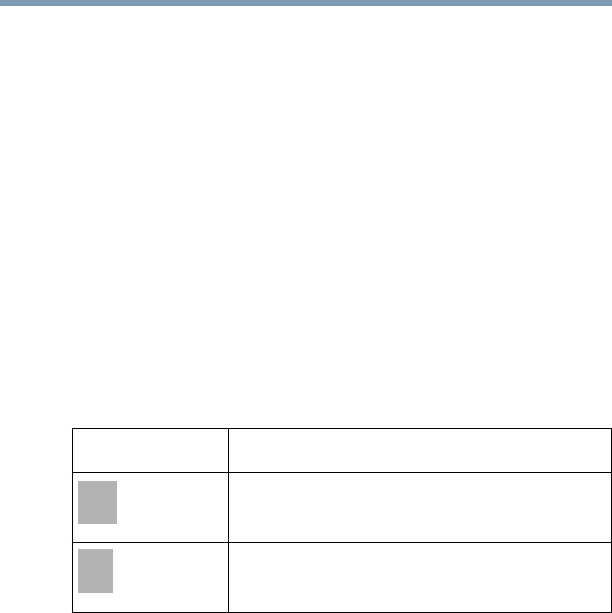
18 Getting Started with Your gigabeat®
Installing the software
Charging the gigabeat®
❖Connect the gigabeat® to your computer using the provided
USB cable.
❖Make sure your computer is connected to the AC adaptor.
❖Turn on your computer.
❖Even if the gigabeat® power is not turned on, it will power up
automatically and the built-in battery will start to charge.
❖When Windows Media® Player is open on your computer, the
message “The gigabeat is now connected” may appear on the
gigabeat® screen depending on the condition of your computer.
In this case, refer to “Connecting your computer and the
gigabeat®” on page 20.
❖The battery icon in the bottom right-hand corner of the screen
will change to indicate that the built-in battery is now charging.
Additional information
❖If the gigabeat® is operating, the power remaining in the built-
in battery may still drop even while it is charged via USB
connection.
❖The built-in battery may not be charged via USB connection on
certain computer models with a USB bus power-supply
function that does not support this charge mode.
❖If the gigabeat® is USB-connected to a computer that does not
support USB charge, the gigabeat® may be disconnected
immediately and the USB function of your computer may be
temporarily disabled. If this happens, remove the gigabeat® and
restart your computer.
❖Proper operation is not guaranteed when the gigabeat® is
connected to a computer using a USB hub.
❖You can also charge the gigabeat® using a dedicated USB AC
adapter (model: MEPUAA10) which is sold separately.
Battery icon Condition of built-in battery
Charging
Recharge complete

19
Getting Started with Your gigabeat®
Installing the software
❖To charge the gigabeat® using a commercially available
general-purpose USB AC adapter, make sure the adapter has a
supply voltage rating of 5 V and bears a PSE mark. Note,
however, that proper operation is not guaranteed.
❖Charge the battery within the operating temperature range
(5qC to 35qC). It may not be charged at temperatures above or
below the specified range.
❖Charge may be stopped temporarily to limit the rise of
gigabeat® temperature. If you encounter this situation, wait for
a while. Charge will resume automatically once the gigabeat®
temperature drops to a safe level.
❖The remaining battery power can be checked with the battery
icon on the screen.
❖If the following message appears while you are using the
gigabeat®, take action to charge the battery sufficiently.
“The remaining battery power is low. The gigabeat® will be out
of power soon.”
❖If the remaining battery power has reached zero and the
gigabeat® has turned off as a result, charge the battery
sufficiently before using the gigabeat® again. If the battery is
not sufficiently charged, the power may not turn on.
Turning ON/OFF the power
1To turn ON the gigabeat® power, slide the power switch to the
ON/OFF position and release the switch.
To turn off the power, slide the power switch to the ON/OFF
position again and release the switch.
(Sample Illustration) Turning the power ON or OFF
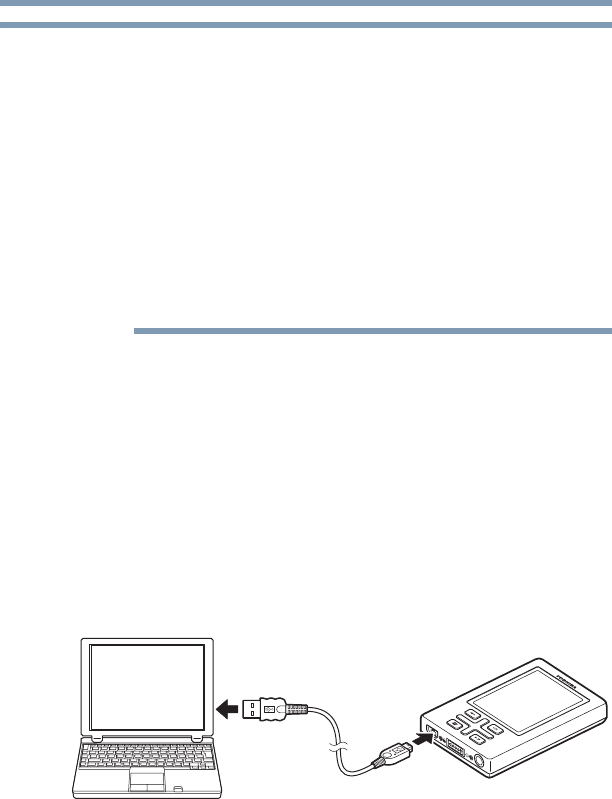
20 Getting Started with Your gigabeat®
Installing the software
❖The backlight of the screen will turn off if the gigabeat® has not
been operated for a specified time, except when video data is
playing, photo data is being displayed in a slide show, or a
USB connection is active. Otherwise, if the gigabeat® has not
been operated for a specified time, the power will turn OFF
approximately 10 minutes after the last operation. Although
the backlight is turned off, the power does not turn off
automatically while music is playing.
See Also: “Setting the backlight off time ” on page 96.
❖If any button on the gigabeat® is pressed while the backlight of
the screen is turned off, the screen will turn on and the
gigabeat® will accept the applicable operation command.
Connecting your computer and the gigabeat®
Connect your computer and the gigabeat® via USB to transfer audio
data, to the gigabeat®.
1Start your computer.
2Connect your computer and the gigabeat® using the provided
USB cable.
Connect to the USB port of your computer.
Even if the gigabeat® power is not yet turned on, the gigabeat®
will power up automatically.
(Sample Illustration)
NOTE
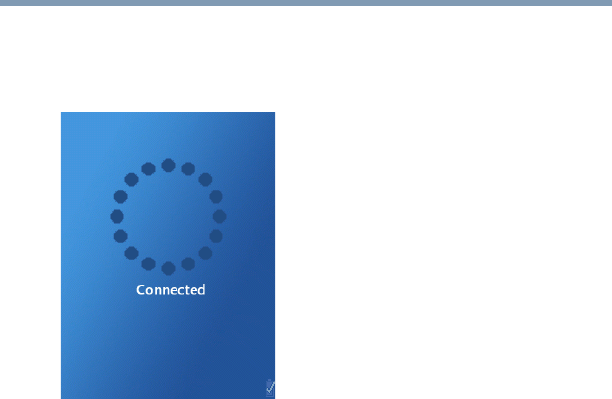
21
Getting Started with Your gigabeat®
Installing the software
3Start Windows Media® Player 11 or 10.
“The gigabeat® is now connected” will appear on the gigabeat®
screen as shown below.
(Sample Image) gigabeat® connection
❖If the gigabeat® is connected to a computer that does not
have Windows Media® Player 11 or 10 installed, the
“Found New Hardware Wizard” will start. If this wizard
starts, close it. Then install Windows Media® Player 11 or
10 following the steps in “Installing the software” on
page 16.
❖The “Found New Hardware Wizard” may still appear if
Windows Media® Player 10 is pre-installed. This is
because the necessary patch is not yet installed. Follow the
steps in “Installing the software” on page 16 to install the
patch.
❖When you connect the gigabeat® for the first time, your
computer will display the screen where you can select
what will happen every time the gigabeat® is connected.

22 Getting Started with Your gigabeat®
Installing the software
❖If your computer is started or restarted or any of its operation
resumed while the gigabeat® is still connected to the
computer, your computer may stop before completing the
startup process or resumption of operation depending on the
specification of your computer. In this case, remove the
gigabeat® from your computer and restart the computer.
❖If your computer has entered and exited the Standby mode or
Sleep mode while gigabeat was still connected, the computer
may no longer communicate with the gigabeat® properly. If
this happens, connect your computer and the gigabeat® again.
❖Once you have connected your computer and the gigabeat®
and the message “The gigabeat® is now connected” appears
on the screen, the gigabeat can no longer be operated. If the
gigabeat® is connected to your computer while music is
playing, the playback will stop.
❖Do not use a USB hub to reconnect the gigabeat® and your
computer. If you use a USB hub the gigabeat®/computer may
not function.
Removing the gigabeat® from your computer
After the dots have stopped circling and while the message “The
gigabeat® is now connected” is shown on the screen, unplug the
USB cable from the gigabeat®.
While data is being transmitted between your computer and the
gigabeat®, “Updating data” and other messages are shown on the
gigabeat® screen. Do not unplug or plug the USB cable while the
screen indicates that processing is still in progress (see the image
NOTE
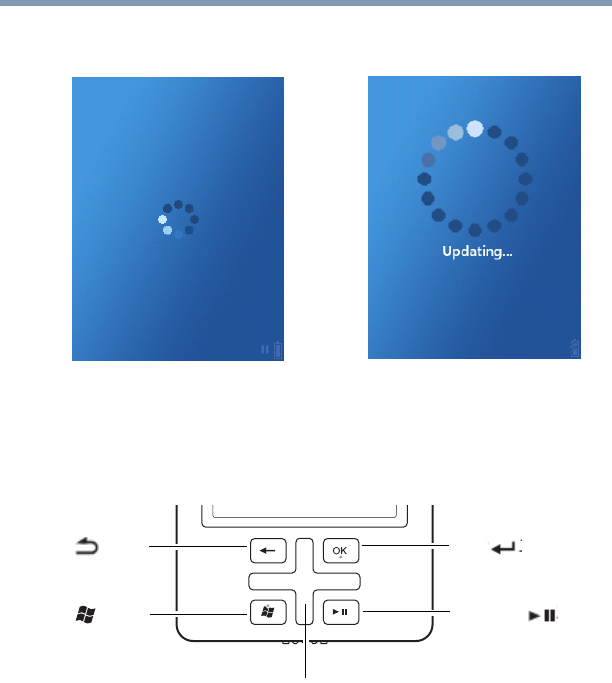
23
Getting Started with Your gigabeat®
Basic gigabeat® operations
below). Unplugging/plugging the USB cable in this condition may
damage the data stored in your gigabeat®.
(Sample Image)
Basic gigabeat® operations
Names and functions of gigabeat® buttons
(Sample Image)
Back button Return to the previous screen.
Start button Display the start screen where you can select a desired
menu.
Enter button Confirm the selected item and execute the applicable
function.
Play/Pause button Play data or pause the data currently playing.
Start ( ) button
Enter ( ) button
Play/Pause ( ) button
Back ( ) button
Up/Down/Left/Right buttons
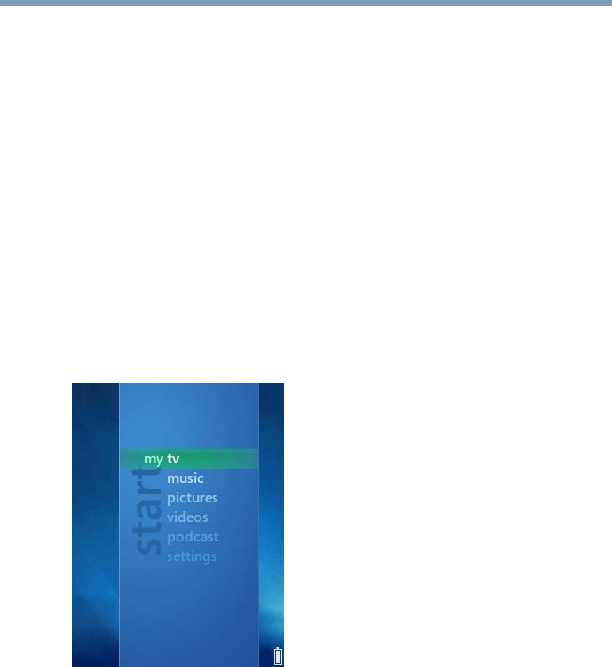
24 Getting Started with Your gigabeat®
Basic gigabeat® operations
Start screen
The start screen serves as the main gigabeat® screen.
All menus can be selected on this screen.
Pressing the start button while another screen is shown will display
the start screen.
(Sample Image)
Up/Down/
Left/Right buttons
Press the Up, Down, Left and Right buttons to select a
desired menu or item.
Use the Up or Down button to increase or decrease the
volume.
Use the Left or Right button to skip to the previous or next
data. (If the buttons are held down, the gigabeat® fast
rewinds or fast forwards.)
My TV Play TV programs recorded and transferred from a
computer (TV programs recoded using Windows
Media Center)
My Music Play music data transferred from a computer
My Pictures View photo data transferred from a computer or
digital camera
My Video Play video data transferred from a computer
podcast Download content from a podcast site
Settings Configure various gigabeat® settings
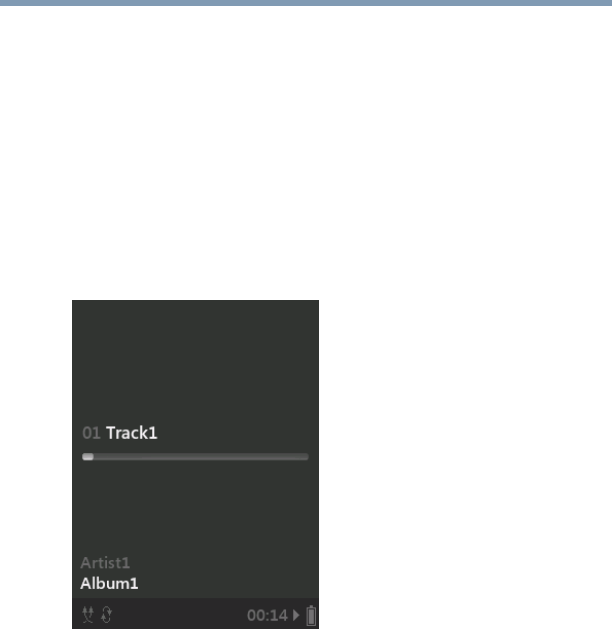
25
Getting Started with Your gigabeat®
Basic gigabeat® operations
Select an item
Press the up or down button to navigate through the selection items.
Press the Left or Right button to change the item screen.
Confirm the selected item
Press the Enter button, and the selected item will be executed.
Battery icon
You can check the remaining battery power with the battery icon
shown in the bottom right-hand corner of the screen.
(Sample Image) Battery icons
Battery icons
Recharging
Remaining battery power
Recharging complete
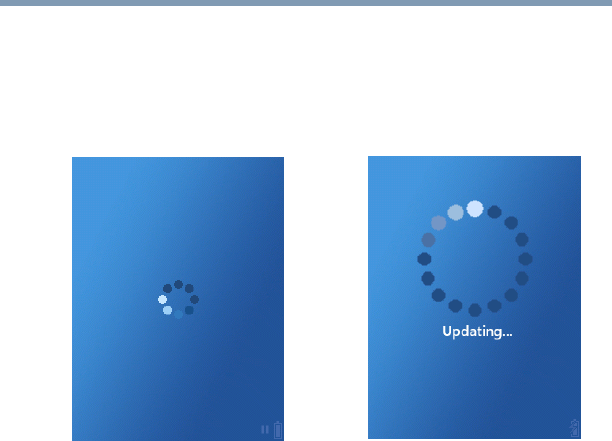
26 Getting Started with Your gigabeat®
Basic gigabeat® operations
Standby screen
The Standby screen appears while the gigabeat® is processing. The
gigabeat® cannot be operated while this screen is shown (dots are
circling). Wait for this screen to disappear before operating the
gigabeat®.
(Sample Image)

27
Chapter 2
Music and Your gigabeat®
Preparing music data
Loading songs from a music CD to your computer
You can load songs to your computer from a desired music CD
using Windows Media® Player 11 or 10. Once loaded to your
computer, the songs can be transferred to the gigabeat®.
gigabeat® is intended for recording, downloading, storage, and/or
playback of authorized content and any other lawful use.
(Using Windows Media® Player 11)
1Set the music CD in the optical drive of your computer.
2Start Windows Media® Player 11.
3Click the Rip tab at the top.
A list of songs in the CD will appear.
4Clear the check boxes of songs you do not want to load.
When the check box at the top of the list is selected, you can
select or clear desired songs.
NOTE

28 Music and Your gigabeat®
Preparing music data
5Click the Rip button.
Downloading of the selected songs will start.
(Sample Image)
❖The loading procedure is roughly the same with Windows
Media® Player 10. For details, refer to the Help file in
Windows Media® Player 10.
❖The selected songs will be saved in your My Music folder and
can be viewed using the Library function of Windows Media®
Player 11.
❖You can click below the Load tab, select Other Options,
select Load Music, and change the save location, format,
sound quality, etc., in the displayed setting screen.
❖If your computer is connected to the Internet and the data for
the applicable music CD is available on the Microsoft® server,
the album name and track names are automatically filled in.
❖For details, see the Windows Media® Player 11 Help file.
<4> Check box <3> Load tab <5> Load button
PLACE HOLDER
NOTE

29
Music and Your gigabeat®
Preparing music data
Transferring audio files on your computer to the gigabeat®
Using Windows Media® Player, you can transfer MP3, WMA
(Windows Media® Audio) and WAV (Wave) audio files stored on
your computer to the gigabeat®.
You can also purchase and download music data from online stores.
For details, refer to the Windows Media® Player 11 Help file.
(Using Windows Media® Player 11)
1Connect your computer and the gigabeat® using the USB cable.
Refer to “Connecting your computer and the gigabeat®” on
page 20 for more information.
A window opens in which you choose the operation performed
when the gigabeat® is connected. Do not connect other devices
using an Media Transfer Protocol connection while connecting
the gigabeat®. Connecting other devices at the same time may
prevent your computer from recognizing the gigabeat®.
2Select Synchronize media files to this device using Windows
Media® Player, and click OK.
If you want to automatically start Windows Media® Player 11
without showing this screen every time the gigabeat® is
connected, select the Always perform the selected action
check box.
Windows Media® Player 11 will start and the device setting
screen will appear.
3Click Finish or Cancel.
Clicking the Cancel button will let you transfer data manually
to the gigabeat®. Proceed to step 4.
Clicking the Finish button will start transfer (synchronization).
Every time the gigabeat® is connected to your computer from
now on, the two will be synchronized automatically and data
will be transferred to your gigabeat®.

30 Music and Your gigabeat®
Preparing music data
If automatic synchronization is set, deleting synchronized data
from your computer will delete the same data from the
gigabeat® when the gigabeat® is connected to your computer
next time.
Therefore, avoid using the gigabeat® to back up your library in
your computer.
(Sample Image)
4Click the ® tab in Windows Media® Player 11, and select the
data you want to transfer (synchronize).
Select Music from the Category Selection button beforehand.
(Sample Image) Category Selection button Synchronization tab
PLACE HOLDER
PLACE HOLDER

31
Music and Your gigabeat®
Preparing music data
5Right-click the selected data, and select Add to
“Synchronized List” in the displayed short-cut menu.
The data will be added to the synchronization list on the right
side of the screen.
You can also drag and drop the data to the synchronization list
area on the right to add the data to the synchronization list.
(Sample Image)
6Click the Synchronize button in the bottom right-hand corner.
Synchronization will start.
While data is being synchronized, the Synchronize button
changes to the Stop button. Once the synchronization is
finished, the button text will change to Synchronize again.
For details, refer to the Windows Media® Player 11 Help file.
(Sample Image) Synchronize/Stop button
PLACE HOLDER
PLACE HOLDER

32 Music and Your gigabeat®
Preparing music data
❖If you are using Windows Media® Player 10, refer to the
Windows Media® Player 10 Help file.
❖Licensed (DRM-protected) WMA files may not be transferred
to the gigabeat® depending on the terms of the applicable
license. (The same applies when Windows Media® Player 10
is used.)
❖Depending on their format, some WMA files may be converted
to a gigabeat®-supporting format when the files are transferred
to the gigabeat. (The same applies when Windows Media®
Player 10 is used.)
❖Large files which exceed 2 GB in size or recording time
exceeds 9 hours 6 minutes cannot be played properly on the
gigabeat®. (The same applies when Windows Media® Player
10 is used.)
❖To change the method of synchronization between your
computer and the gigabeat®, click below the
Synchronization tab in Windows Media® Player 11, select
gigabeat T, select Synchronization Settings, and set
desired items.
❖Always use Windows Media® Player 11 or 10 when
transferring data to the gigabeat®. Never use any other method
of transfer.
NOTE

33
Music and Your gigabeat®
Preparing music data
Synchronization settings (Windows Media® Player 11)
To change the method of synchronization between your computer
and the gigabeat®, click below the Synchronization tab in
Windows Media® Player 11, select gigabeat T, select
Synchronization Settings, and set desired items.
(Sample Image)
You can set the playlists to be synchronized by following the steps
below.
1Select the check mark in the top left-hand corner.
2Select the playlists you want to synchronize under Avail able
Playlists.
3Click the Add button.
The selected playlists will move to Playlists to Be
Synchronized.
4Click the Finish button.
The playlists will be set for synchronization and
synchronization will start.
You can delete a playlist you no longer want to synchronize, by
selecting the playlist under Playlists to Be Synchronized and
then clicking the Delete button.
PLACE HOLDER
NOTE

34 Music and Your gigabeat®
Preparing music data
Transferring an album jacket photo
To transfer an album jacket photo (album art), you must load the
album information including album art beforehand using Windows
Media® Player 11 or 10.
Transfer the music data in the album after loading the album
information including album art, and the album art will be
transferred together.
How to load album information
1In the Library tab, right-click an album, and click Find
Album Information.
2Find the album information you want to load.
3Click Finish.
Registering a desired image as an album art (jacket photo)
If you could not find the desired album art (jacket photo) through
the album information search, you can still register a desired image
as an album art.
(Using Windows Media® Player 11)
1On your computer, right-click the JPEG file you want to
register as album art, and select Copy.
2In the library in Windows Media® Player 11, right-click the
album you want to register, and select Paste Album Art.
The album art will be registered.
3Transfer to (synchronize with) the gigabeat® the music data
and album art that you have just registered.
You can also drag and drop a JPEG file to a desired album to register
the JPEG file as the album art for that album.
(Using Windows Media® Player 10)
1Change the name of a desired JPEG file to “Folder.jpg,” and
put the file in the folder containing the music data of the album
you want to register.
2Start Windows Media® Player 10.
3Transfer to (synchronize with) the gigabeat® the music data
and album art that you have just registered.
NOTE
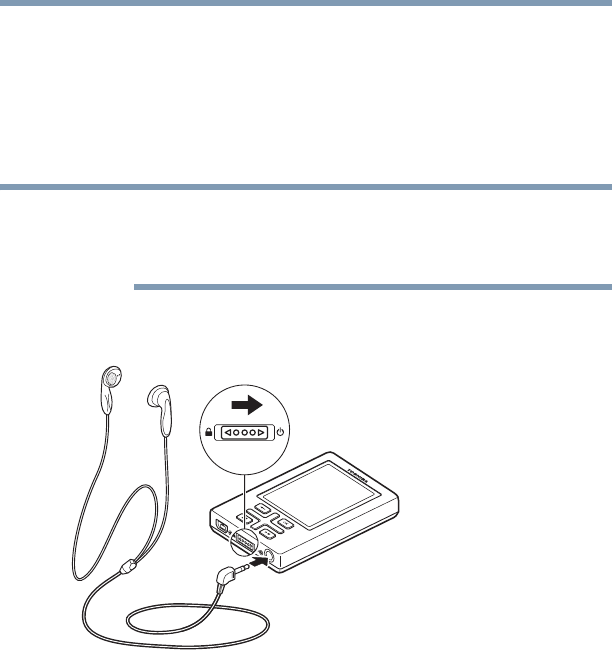
35
Music and Your gigabeat®
Listening to music
Listening to music
Listening to selected music
You can select desired music by such categories as “song,” “genre,”
“album” and “artist” based on the information appended to the
music data that has been transferred to the gigabeat®.
Music data not accompanied by any artist name, genre or album is
classified as “No Information” under each category.
Example: Selecting a Song by “Artist”
1First, connect the earbuds to the headphone jack and turn on
the power.
(Sample Illustration)
2Select My Music on the start screen, and press the Enter
button.
NOTE
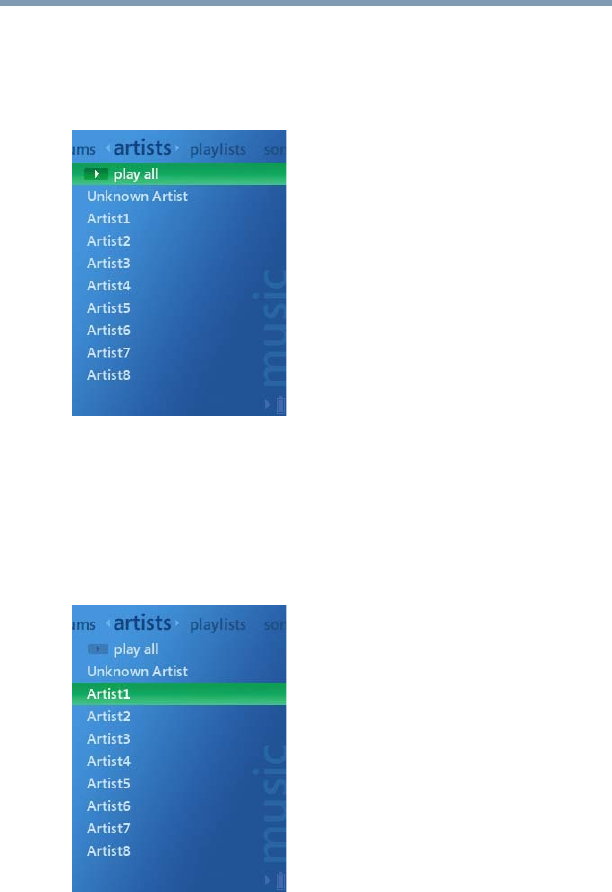
36 Music and Your gigabeat®
Listening to music
3Press the left or right button to display the Artists screen.
This step assumes that a song is selected from the Artists
screen. You can also select the song you want to play from the
Songs,Genres,Albums or Playlists screen.
(Sample Image)
4Select the artist you want to listen to, and press the Enter
button.
A screen showing a list of albums by the selected artist will
appear.
You can select Play All to play all songs.
(Sample Image)
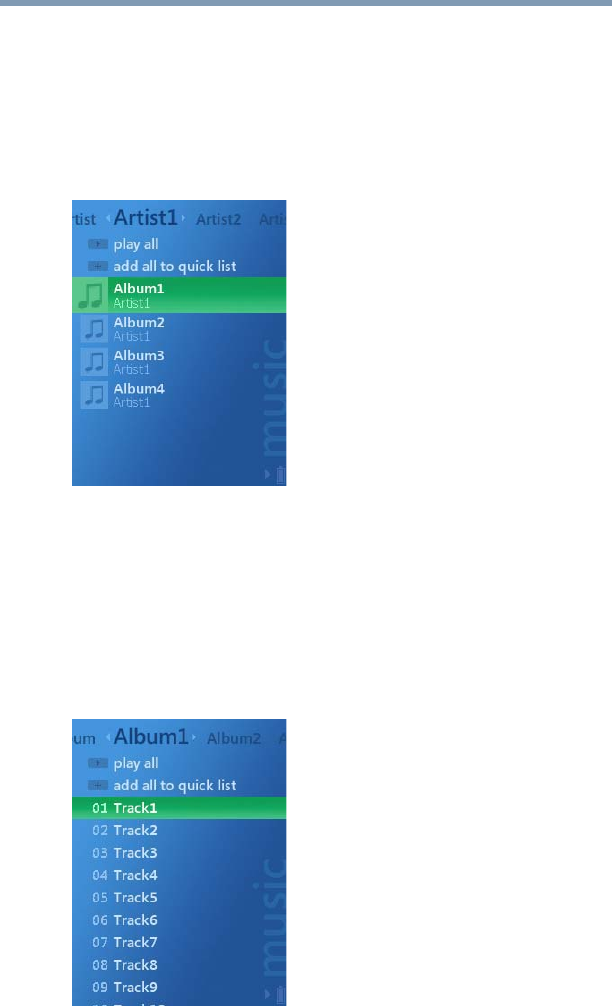
37
Music and Your gigabeat®
Listening to music
5Select the album you want to listen to, and press the Enter
button.
A screen showing a list of songs in the selected album will
appear.
You can also select a song not contained in the album. To do
this, select a desired song and press the Enter button, and a
screen showing the title of the selected song will appear.
(Sample Image)
6Select the song you want to listen to, and press the Enter button
or Play/Pause button.
When the Enter button is pressed:
A screen showing the title of the selected song will appear.
Press the Enter button again, and the music will be played.
When the Play/Pause button is pressed:
The music will be played.
(Sample Image)

38 Music and Your gigabeat®
Listening to music
❖Turn the gigabeat® OFF before connecting or disconnecting
the earbuds.
❖Firmly insert the earbud plug fully into the jack. The earbuds
will not work properly unless the plug is fully inserted.
❖The gigabeat® may not be able to play WMA files containing
data that is copyright-protected by Windows Media® DRM10,
in which case one of the following error messages may appear:
1) “The data has expired.” (The period during which the data
can be played has expired and consequently the data cannot
be played. You must renew the subscription on your computer
subscribing to the applicable WMA data, and connect the
gigabeat® to and synchronize it with your computer.)
2) “Synchronize the gigabeat® with the computer.” (This
message is displayed when the gigabeat® has not been
connected to your computer for some time. If this message
appears, connect the gigabeat® to your computer via USB and
synchronize it with Windows Media® Player 11 or 10. The
gigabeat® should be able to play the data. This error message
may also be displayed when the applicable data has expired. In
this case, take the action explained in step 1.)
NOTE
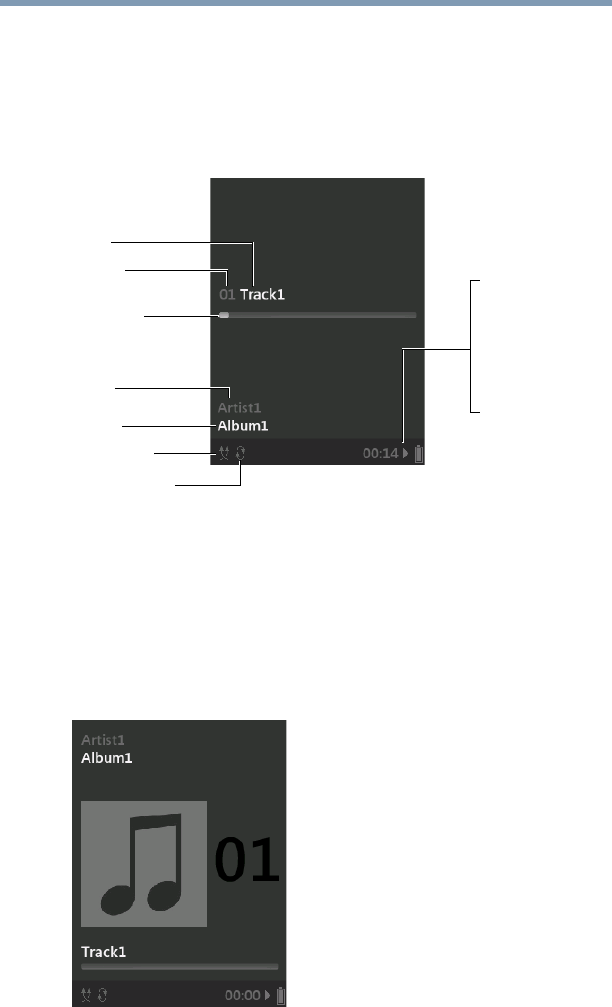
39
Music and Your gigabeat®
Playback screens
Playback screens
While music is playing, you can display one of the three playback
screens, playback-screen selection screen, track list screen, or
music setting screen shown below. Press the Enter button to switch
among the three playback screens and playback-screen selection
screen.
(Sample Images) Playback screen
Elapsed time or remaining time
You can switch between the elapsed time display and remaining
time display by selecting Settings ÆMusic ÆDisplayed Time
from the start screen.
The information regarding the music currently playing, elapsed or
remaining time, and jacket photo, are shown.
(Sample Image)
Song name
Pause
Fast rewind
Fast forward
Track number
Album name
Continuous playback
Artist name Lock
Elapsed time bar
Random Playback
Play
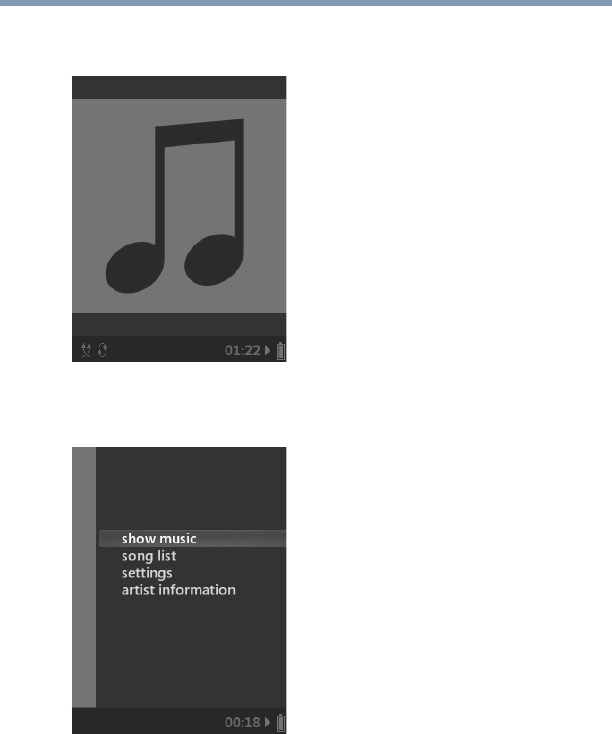
40 Music and Your gigabeat®
Playback screens
An enlarged view of the jacket photo of the music currently
playing, and elapsed time or remaining time, are shown.
(Sample Image)
Playback-screen selection screen
(Sample Image)
You can select the “track list screen” or “music setting screen” on
the playback-screen selection screen to display the selected screen.
Press the Back button on each screen, and the playback-screen
selection screen will appear again.
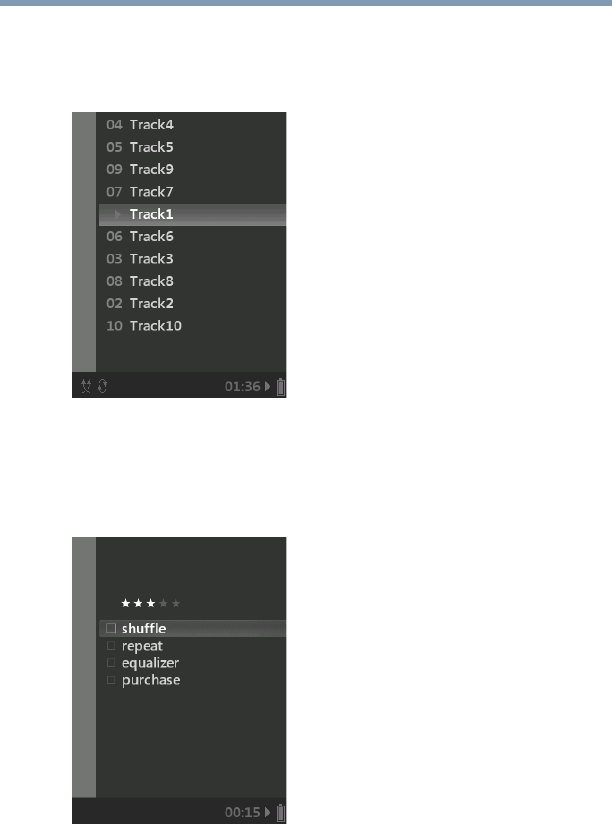
41
Music and Your gigabeat®
Playback screens
Track list screen
The track list of the music currently playing, part of the jacket
photo, and elapsed time, are shown.
(Sample Image)
Music setting screen
The music play mode and equalizer settings can be specified, and
music data can be rated.
(Sample Image)
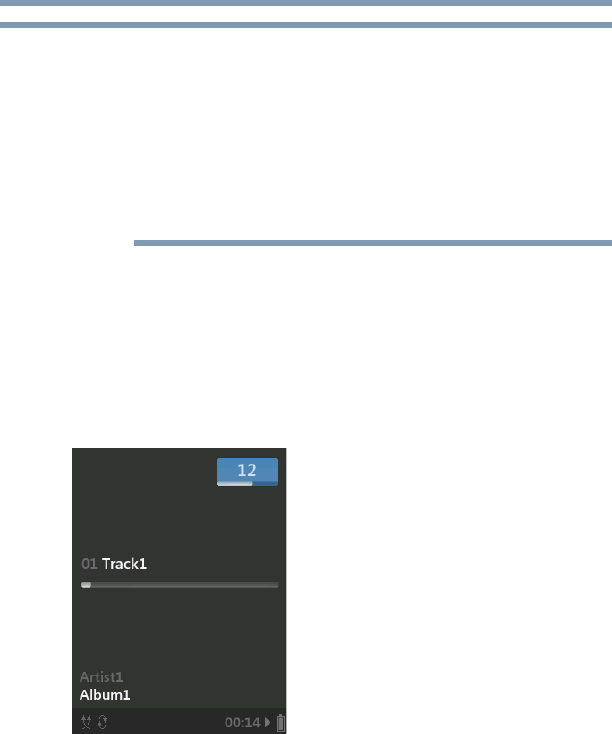
42 Music and Your gigabeat®
Functions available during playback
❖You can press the Enter button on the track list screen to play
the selected song from the beginning.
❖If you select the Purchase check box on the music setting
screen, a web page where you can make online purchases will
be displayed on your Internet browser the next time the
gigabeat® is connected to your computer.
❖The jacket photo will not be shown unless the photo has been
transferred.
Functions available during playback
Adjusting the volume
Press the up or down button while the playback screen is displayed.
The volume will be shown for approximately 1 second, and the
volume will change every time the button is pressed.
(Sample Image)
Pausing
Press the Play/Pause button.
Press the button again, and the remainder of the music will be
played.
NOTE

43
Music and Your gigabeat®
Listening repeatedly/changing the play sequence
Returning to the beginning of a song or skipping to the previous or next
song
Press the Left button.
The gigabeat® will return to the beginning of the song currently
playing.
If no more than 2 seconds of music data has been played since the
beginning of the song, the gigabeat® will skip to the beginning of
the previous song.
Press the Right button.
The gigabeat® will skip to the next song.
Fast rewinding/forwarding
Press and hold the Left button.
The gigabeat® will fast rewind the data.
Press and hold the Right button.
The gigabeat® will fast forward the data.
When the button is released, the song will be played from the
position achieved by fast rewinding/forwarding.
Displaying the start screen
To use a different function, display the start screen and select a
different menu.
Press the Start button.
The start screen will appear while the music is still playing.
Press the button again, and the start screen will disappear.
Listening repeatedly/changing the play sequence
Listening repeatedly
You can listen to the music data selected by artist, genre, album or
playlist repeatedly.
1While music is playing, press the Enter button several times to
display the playback-screen selection screen.
Refer to “Playback-screen selection screen ” on page 40.
2Select Music Setting Screen, and press the Enter button.
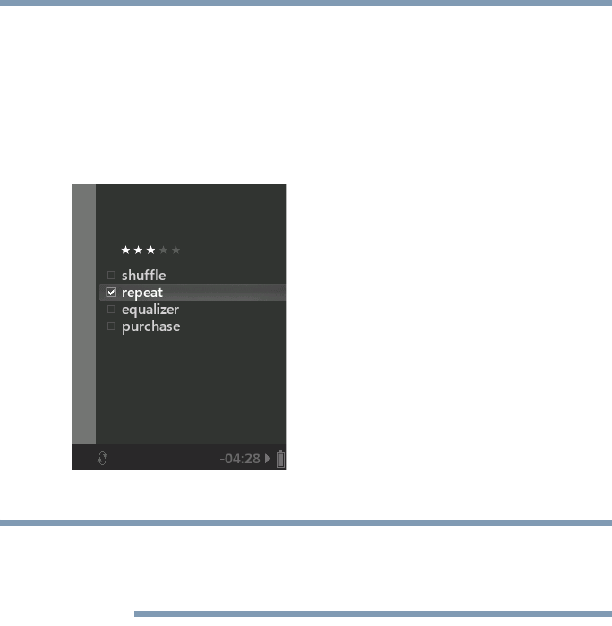
44 Music and Your gigabeat®
Listening repeatedly/changing the play sequence
3Select Continuous, and press the Enter button.
The check box will be selected and the current music will be
played repeatedly.
If an artist is currently selected, all songs by the artist will be
played repeatedly. If an album is currently selected, all songs in
the album will be played repeatedly.
(Sample Image)
You can also set the repeat playback mode when music is not
playing. Select Settings ÆMusic ÆContinuous from the start
screen.
Changing the play sequence
You can listen to the music data selected by artist, genre, album or
playlist randomly.
1While music is playing, press the Enter button several times to
display the playback-screen selection screen.
Refer to “Playback-screen selection screen ” on page 40.
2Select the Music Setting Screen, and press the Enter button.
NOTE
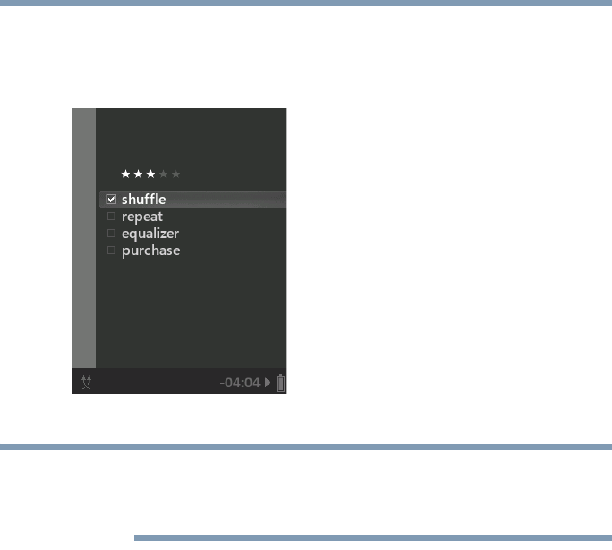
45
Music and Your gigabeat®
Changing the sound quality
3Select Random, and press the Enter button.
The check box will be selected and the selected music data will
be played randomly.
(Sample Image)
You can also set the random playback mode when music is not
playing. Select Settings ÆMusic ÆRandom from the start
screen.
Changing the sound quality
Changing the equalizer
You can select a desired equalizer mode.
1While music is playing, press the Enter button several times to
display the playback-screen selection screen.
Refer to “Playback-screen selection screen ” on page 40.
2Select the Music Setting Screen, and press the Enter button.
NOTE
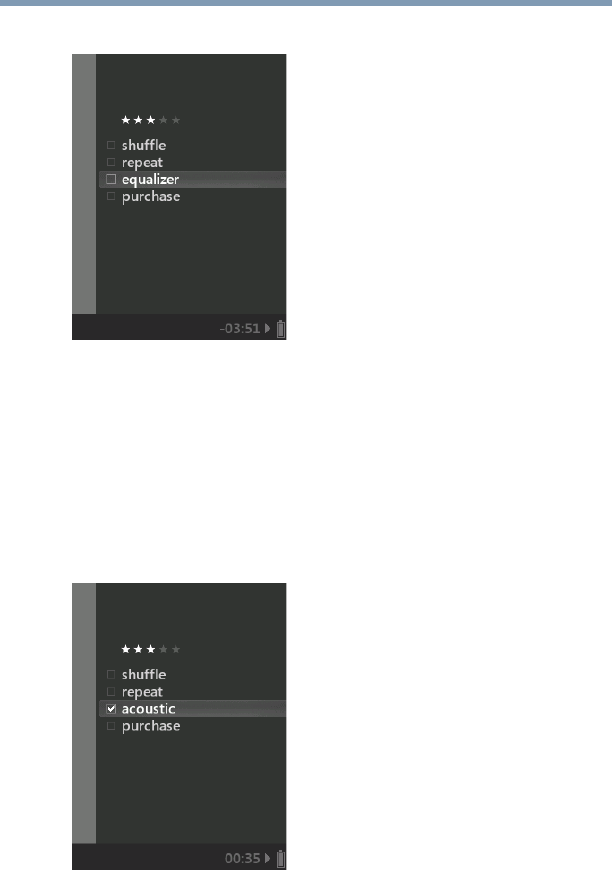
46 Music and Your gigabeat®
Changing the sound quality
3Select the Equalizer line.
(Sample Image)
4Press the Enter button and select a desired sound quality mode.
The equalizer setting will change in the following sequence
every time the Enter button is pressed:
None (nothing is selected) ÆAcoustic ÆClassic Æ
Electronic ÆHip Hop ÆJazz ÆPop ÆRock
The equalizer mode will be set and the sound quality will
change accordingly.
(Sample Image)
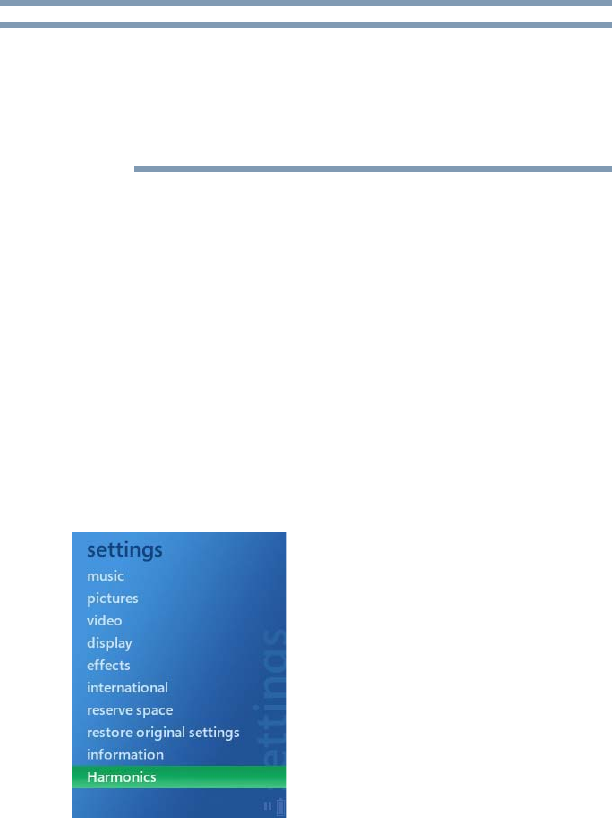
47
Music and Your gigabeat®
Changing the sound quality
❖You can also set the equalizer mode when music is not
playing. Select Settings ÆMusic ÆEqualizer from the
start screen.
❖This function is effective only with the music data saved in My
Music.
Setting/changing the harmonics function
The Harmonics function lets you play music with better quality.
When this function is set, you can listen to music data loaded from
CDs at a level of sound quality close to the original CDs.
Specifically, this function compensates the treble range of 16 kHz
or above that was cut off when the data in a music CD was
compressed to the WMA or MP3 format.
This treble-range compensation technology (H2C Technology) was
developed jointly by Kyushu Institute of Technology’s HIT
Development Center and TOSHIBA.
1Select Settings on the start screen, and press the Enter button.
2Select Harmonics, and press the Enter button.
(Sample Image)
NOTE
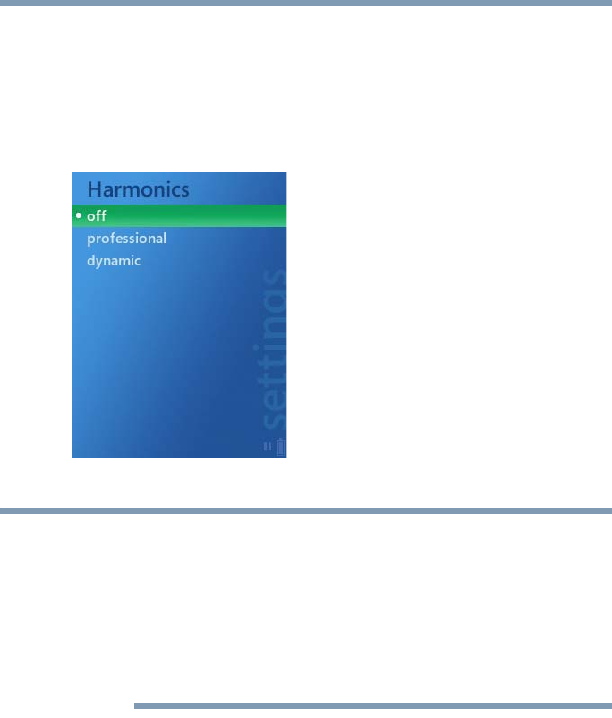
48 Music and Your gigabeat®
Listening to music using a playlist
3Select Professional or Dynamic, and press the Enter button.
Off: H2C Technology is disabled.
Professional: The treble range is compensated.
Dynamic: The treble range is compensated and bass sound is
emphasized.
(Sample Image)
❖Playing with H2C Technology consumes the battery faster, so
the continuous playback time will become shorter compared to
when the Harmonics function is turned off.
❖This function is effective only with the music data saved in My
Music.
❖The benefits of H2C Technology cannot be recognized unless
the sampling frequency of music data is 44.1 kHz or above.
Listening to music using a playlist
Creating a quicklist
By creating a quicklist, you can play your favorite music with ease.
You can also transfer to your gigabeat® any playlist registered in
Windows Media® Player 11 or 10. To transfer a playlist from
Windows Media® Player 11, right-click the desired list and select
Add to “Synchronization List”, just like you do when transferring
a song.
To transfer a playlist from Windows Media® Player 10, set
automatic synchronization and select the playlist you want to
NOTE
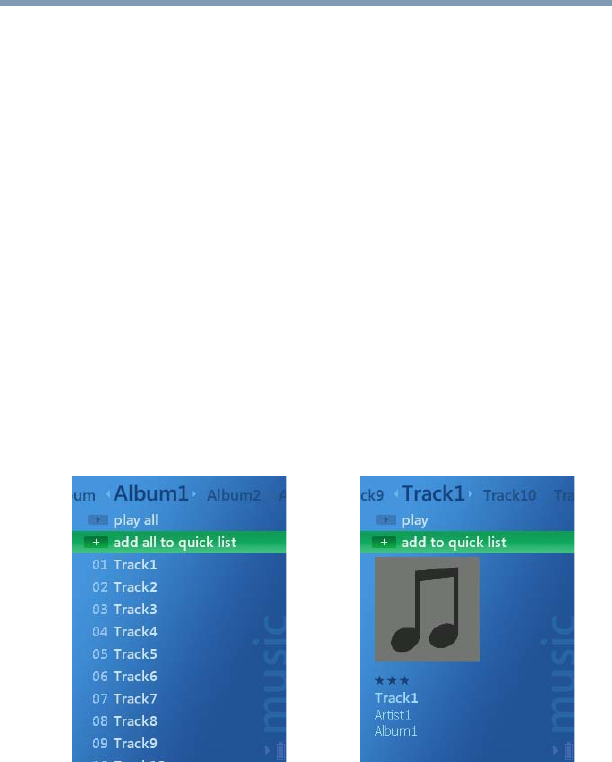
49
Music and Your gigabeat®
Listening to music using a playlist
transfer (synchronize). For details, refer to Windows Media® Player
10 Help file.
1Select My Music on the start screen, and press the Enter
button.
2Press the Left or Right button to select Songs,Genres,
Albums or Artists.
3Select the song or genre, album or artist you want to add to the
quicklist.
4Select Add All to Quicklist or Add to Quicklist, and press the
Enter button.
A message will appear and the music data will be added to the
quicklist.
If you have selected an artist or album and selected Add All to
Quicklist, all songs by the artist or contained in the album will
be added to the quicklist.
For information on how to play the quicklist you have created,
refer to “Playing a playlist ” on page 51.
(Sample Image)
Deleting data from a quicklist
1Select My Music on the start screen, and press the Enter
button.
2Press the Left or Right button to select Playlists.
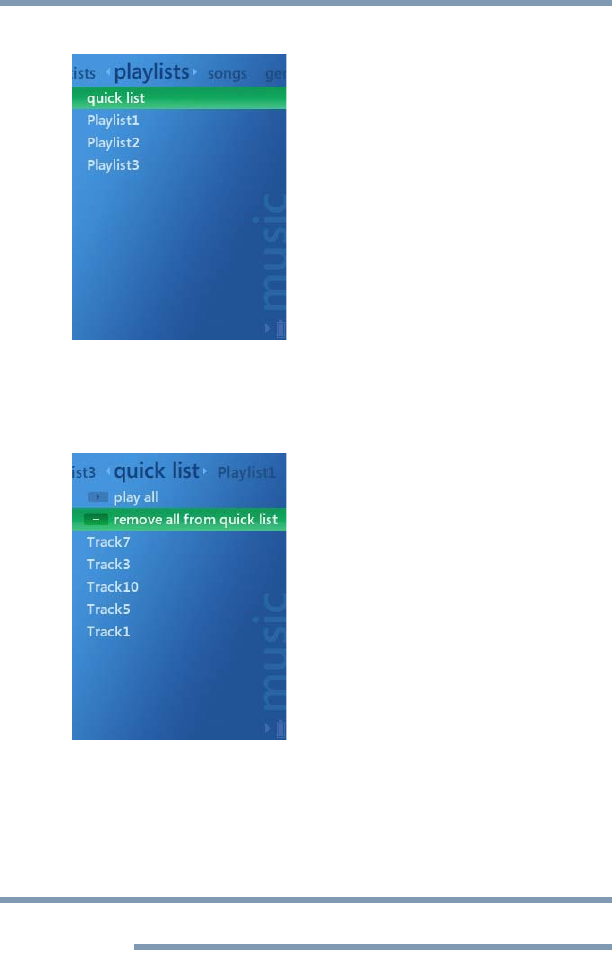
50 Music and Your gigabeat®
Listening to music using a playlist
3Select Quicklist, and press the Enter button.
(Sample Image)
4Select Delete All from Quick List, and press the Enter button.
A confirmation message will appear.
(Sample Image)
5Select Ye s , and press the Enter button.
A message will appear for several seconds, after which all
music data currently registered in the quicklist will be deleted
from the quicklist.
You cannot select and delete a specific song from the quicklist.
NOTE
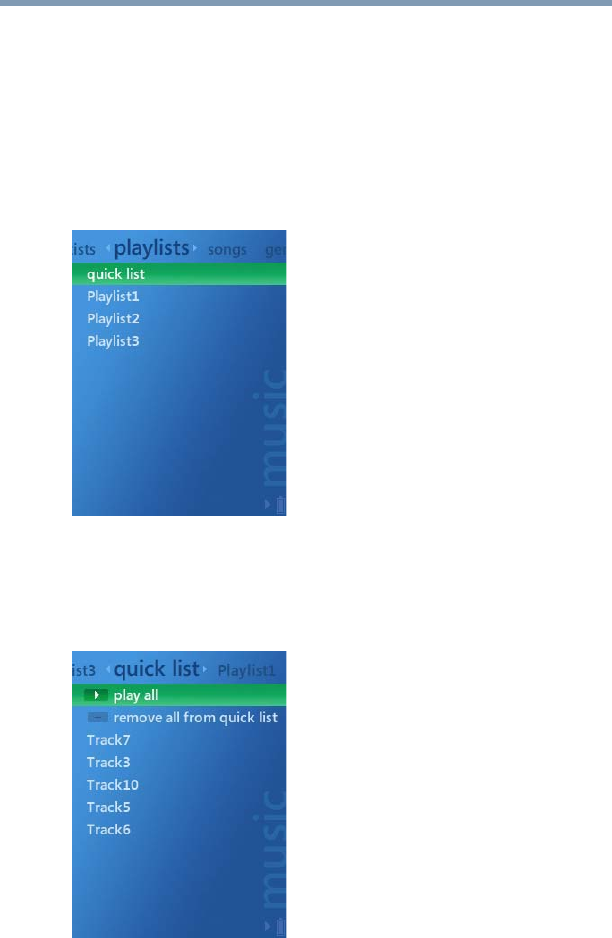
51
Music and Your gigabeat®
Listening to music using a playlist
Playing a playlist
1Select My Music on the start screen, and press the Enter
button.
2Press the left or right button to select Playlists.
3Select Quicklist or any playlist you have transferred using
Windows Media® Player, and press the Enter button.
The registered music will be shown.
(Sample Image)
4Select Play All, and press the Enter button.
The music registered in the quicklist or transferred playlist will
be played.
(Sample Image)
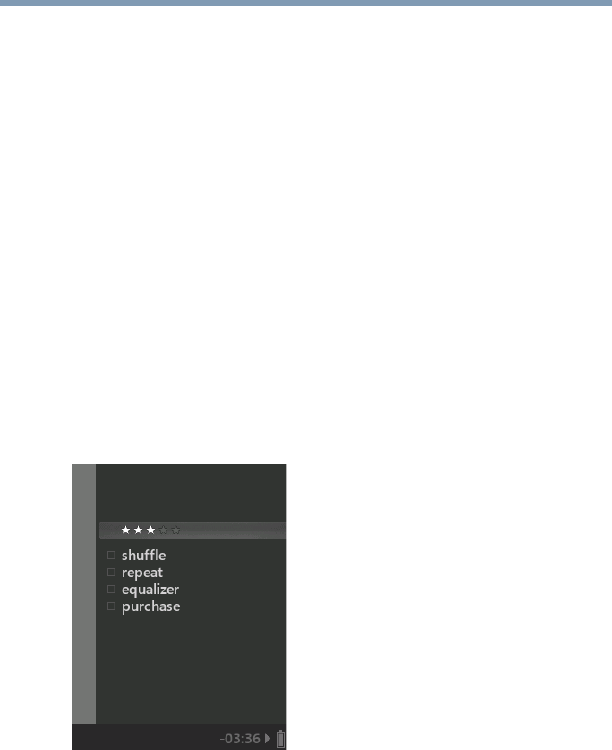
52 Music and Your gigabeat®
Managing music data
Managing music data
Rating music data
You can rate the music currently playing and synchronize the rating
with the rating stored in Windows Media® Player 11 or 10.
You can give ratings of one to five stars (five stars represent the
highest rating).
Windows Media® Player can display music and other data in the
order of their ratings. You can also use the rating as a search
condition when automatically creating a playlist in Windows
Media® Player.
1While music is playing, press the Enter button several times to
display the playback-screen selection screen.
Refer to “Playback-screen selection screen ” on page 40.
2Select Music Setting Screen, and press the Enter button.
3Select the line of stars.
(Sample Image)
4Press the Enter button to change the number of stars.
The number of stars will change every time the Enter button is
pressed.
When the music data is synchronized with Windows Media®
Player 11 or 10, the rating set in the gigabeat® will be reflected
in the corresponding rating in Windows Media® Player 11 or
10.
If a rating is changed in Windows Media® Player 11 or 10, the
corresponding rating in the gigabeat® will be changed when the
gigabeat® is synchronized with your computer.

53
Music and Your gigabeat®
Managing music data
Deleting music data
To delete music data currently saved in the gigabeat®, delete the
same data in Windows Media® Player 11 or 10.
The following steps assume that Windows Media® Player 11 is
used. If you are using Windows Media® Player 10, refer to Help in
Windows Media® Player 10.
1Connect your computer and the gigabeat® using the USB cable.
2Start Windows Media® Player 11.
3Click the Synchronization tab, click the Category Selection
button, and select Music.
4Click the Synchronization tab, and click the gigabeat T
library in the tree shown on the left.
The library in the gigabeat® will be shown.
5Right-click the music data you want to delete, and select
Delete in the displayed menu.
A dialog box to confirm the deletion will appear.
(Sample Image)
6Select Ye s .
The selected music data will be deleted from the gigabeat®.
7After confirming that the music data has been deleted, unplug
the USB cable.
If automatic synchronization is set, deleting synchronized data from
your computer will delete the same data from the gigabeat® when the
gigabeat® is connected to your computer next time.
PLACE HOLDER
NOTE

54
Chapter 3
Photos and your gigabeat®
This chapter presents how to transfer photos to the gigabeat®, view
photos, and delete photos on the gigabeat®.
Transferring photos to the gigabeat®
gigabeat® is intended for recording, downloading, storage, and/or
playback of authorized content and any other lawful use.
You can transfer photo data from your computer to the gigabeat®
using Windows Media® Player 11 or 10.
The following steps assume that Windows Media® Player 11 is
used. If you are using Windows Media® Player 10, refer to the
Windows Media® Player 10 Help file.
Only JPEG image files can be viewed on the gigabeat®.
1Connect your computer and the gigabeat® using the USB cable.
A screen will appear where you can select what will happen
when the gigabeat® is connected.
NOTE
NOTE

55
Photos and your gigabeat®
Transferring photos to the gigabeat®
2Select Synchronize media files to this device using Windows
Media Player, and click OK.
If you want to automatically start Windows Media® Player 11
without showing this screen every time the gigabeat® is
connected from now on, select the Always perform the
selected action check box.
Windows Media® Player 11 will start and the device setting
screen will appear.
(Sample Image)
3Click Finish or Cancel.
Clicking the Cancel button will let you transfer data manually
to the gigabeat®. Proceed to step 4.
(Sample Image)
Clicking the Finish button will start transfer (synchronization).
Every time the gigabeat® is connected to your computer, the
PLACE HOLDER
PLACE HOLDER

56 Photos and your gigabeat®
Transferring photos to the gigabeat®
two will be synchronized automatically and data will be
transferred to the gigabeat®.
This screen will not be displayed if the above setting is already
done. You can set automatic synchronization by clicking below
the Synchronization tab, selecting gigabeat T, selecting
Synchronization Settings, and setting desired items.
4Click the Synchronization tab in Windows Media® Player 11,
click the Category Selection button, and select Image.
5Right-click the data you want to transfer (synchronize), and
Select Add to “Synchronization List” in the displayed short-
cut menu.
The data will be added to the synchronization list on the right
side of the screen.
You can also drag and drop the data to the synchronization list
area on the right to add the data to the synchronization list.
(Sample Image)
6Click the Synchronize button in the bottom right-hand corner.
Synchronization will start.
While data is being synchronized, the Synchronize button
changes to the Stop button. Once the synchronization is
finished, the button text will change to Synchronize again.
For details, refer to the Windows Media® Player 11 Help file.
Always use Windows Media® Player 11 or 10 when transferring data
to the gigabeat®. Never use any other method of transfer.
PLACE HOLDER
NOTE
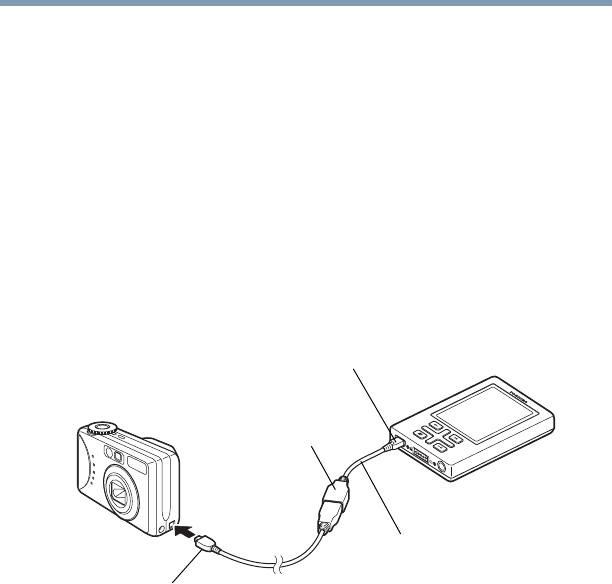
57
Photos and your gigabeat®
Retrieving photo data from a digital camera
Retrieving photo data from a digital camera
You can connect the gigabeat® directly to a USB mass storage
device, PTP digital camera, etc., and transfer the photo data saved
in the connected device, digital camera, etc., to the gigabeat®.
Note that the above operation does not guarantee proper data
transfer from all devices.
A USB conversion cable is needed to connect the gigabeat® to a
digital camera. Purchase a USB conversion cable of “A connector
(female) – Mini B connector (male)” type. (Recommended product:
XXXXX)
1Connect the digital camera and gigabeat® using a USB
conversion cable (purchased by the user).
(Sample Illustration)
2Turn on the gigabeat®, and then turn on the digital camera.
Depending on the digital camera, the camera may power up
automatically when the gigabeat® is turned on.
The confirmation message “Do you want to transfer data to the
gigabeat?” will appear.
3Select Ye s , and press the Enter button.
Photo data, video data and other transferable data currently
saved in the digital camera will be transferred.
A connector
Mini B connector
USB cable that came with
USB conversion cable
(purchased by the user)
the digital camera

58 Photos and your gigabeat®
Retrieving photo data from a digital camera
❖Charge the gigabeat® sufficiently before connecting it to the
digital camera. If data is transferred from the digital camera
while the gigabeat® battery power is low, data recorded in the
gigabeat® may be damaged when the battery runs out in the
middle of transfer operation.
❖Do not unplug or plug the USB cable while the gigabeat® is
processing.
❖Depending on the type of the digital camera, you may need to
switch the camera to an appropriate mode beforehand so that it
can connect to a computer, etc.
❖If the gigabeat® has not enough available space, only the
amount of photo data that can be stored in the available space
will be transferred.
❖Do not use a USB hub to connect the digital camera and
gigabeat®.
❖Due to the limitation imposed by the gigabeat’s USB bus
power-supply function, some digital camera models may not
be connected to the gigabeat® or may cause the USB function
of the gigabeat® to be disabled temporarily. In this case,
remove the digital camera, turn OFF the gigabeat® power, and
then turn on the power again.
❖Steps 1 and 2 can be reversed.
❖The gigabeat® can only recognize one folder in the connected
digital camera. If the digital camera has two or more storage
folders, only one will be recognized.
Deleting photo data
You can delete photo data retrieved directly from the digital camera,
without connecting the gigabeat® to your computer.
1Select My Pictures on the start screen, and press the Enter
button.
2Press the Left or Right button to select View by Folder.
NOTE
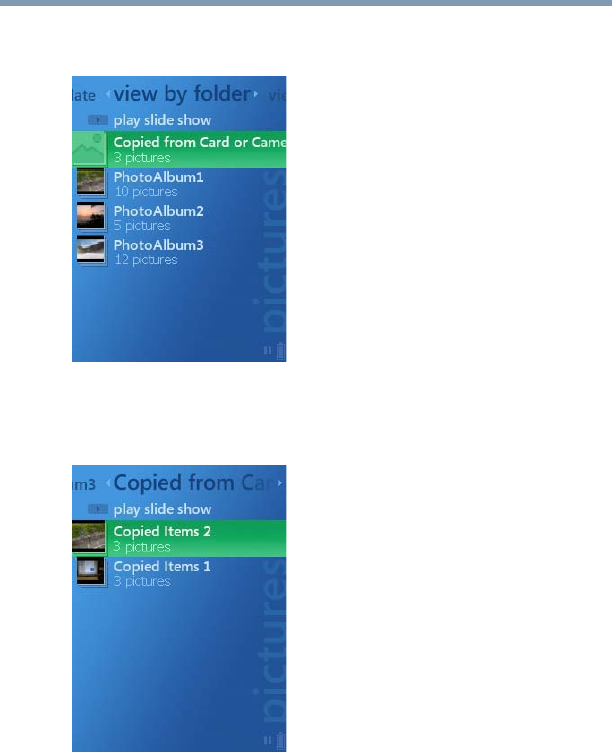
59
Photos and your gigabeat®
Retrieving photo data from a digital camera
3Select Transfer from Card or Camera, and press the Enter
button.
(Sample Image)
4Select the folder containing the photo data you want to delete,
and press the Enter button.
(Sample Image)
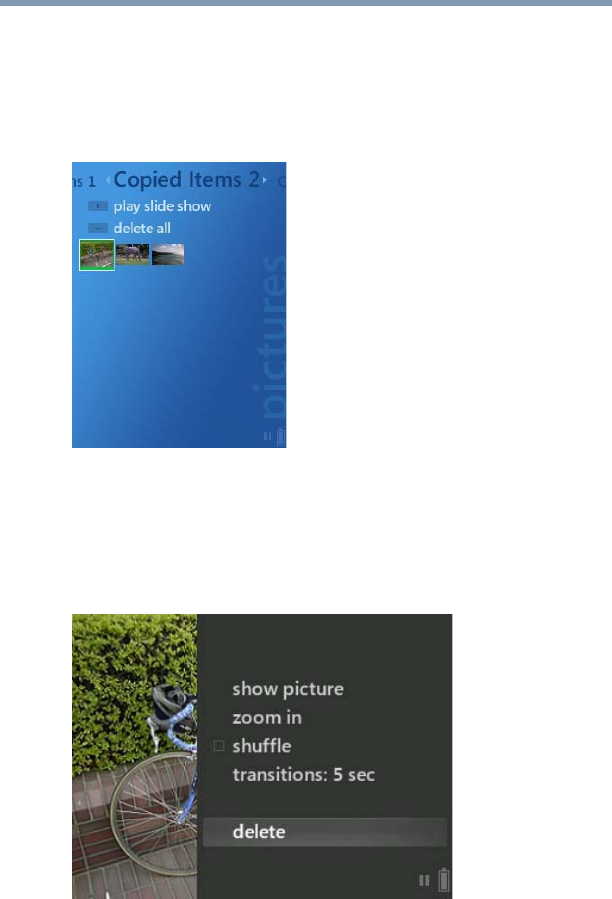
60 Photos and your gigabeat®
Retrieving photo data from a digital camera
5On the Items Already Transferred screen, select the photo
data you want to delete, and press the Enter button.
The selected photos will be shown.
Select Delete All, and all photo data in the folder will be
deleted.
(Sample Image)
6Press the Left or Right button to display the photo setting
screen.
7Select Delete, and press the Enter button.
A confirmation message will appear.
(Sample Image)
8Click Ye s , and press the Enter button.
9A message will appear, indicating that the data has been
successfully deleted.
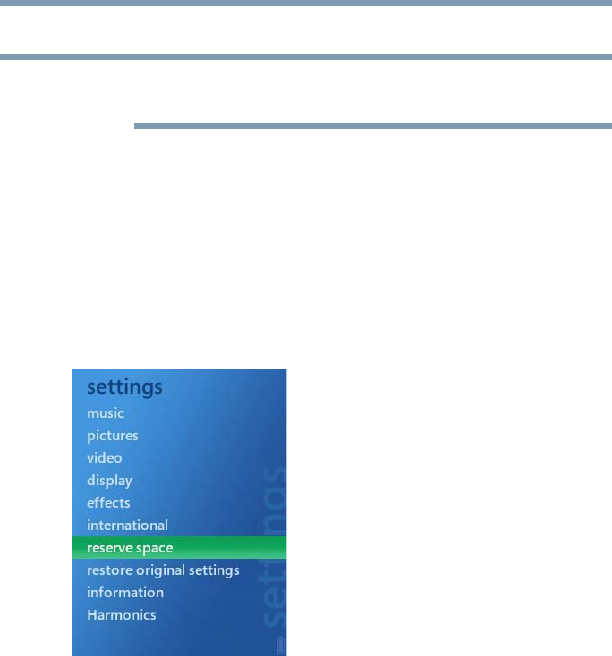
61
Photos and your gigabeat®
Reserving a storage space
10 Press the Enter button.
You can also delete photo data by connecting the gigabeat® to your
computer. Refer to “Deleting photos ” on page 73.
Reserving a storage space
You can reserve a specified portion of the available space in the
gigabeat® for saving photo data to be retrieved directly from a
digital camera.
1Select Settings on the start screen, and press the Enter button.
2Select Reserve Space, and press the Enter button.
A confirmation message will appear.
(Sample Image)
NOTE
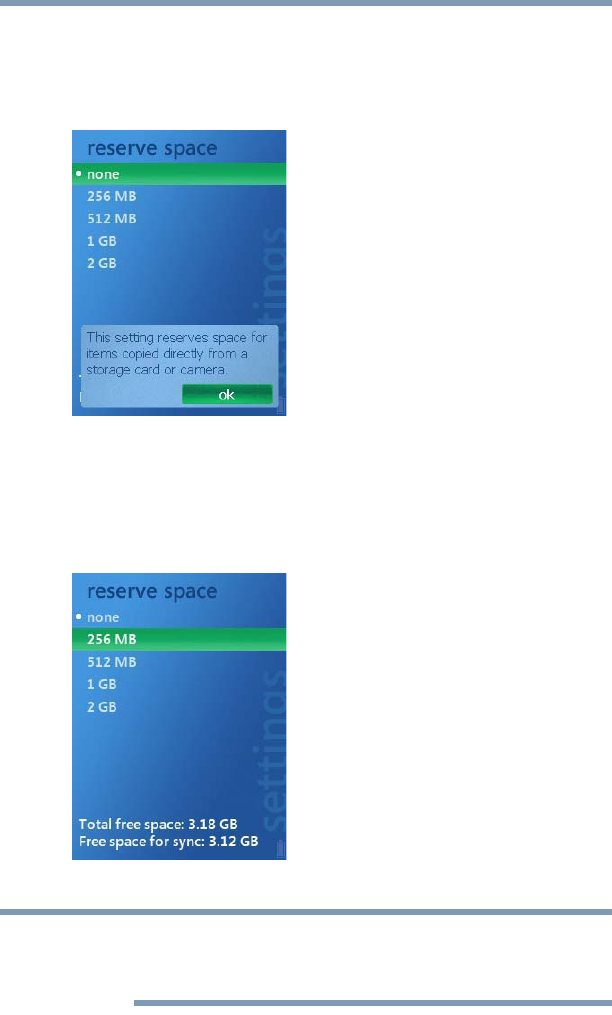
62 Photos and your gigabeat®
Reserving a storage space
3Press the Enter button.
The message will disappear, and the size of the total available
space and that of the available space reserved for
synchronization will be shown.
(Sample Image)
4Select the size of available space you want to reserve, and press
the Enter button.
You can select a desired size from: None,256 MB,512 MB,
1GB,2 GB
(Sample Image)
The space reserved here is used exclusively for photo data input
directly from a digital camera, and none of the data transferred from a
computer will be saved in this space.
NOTE
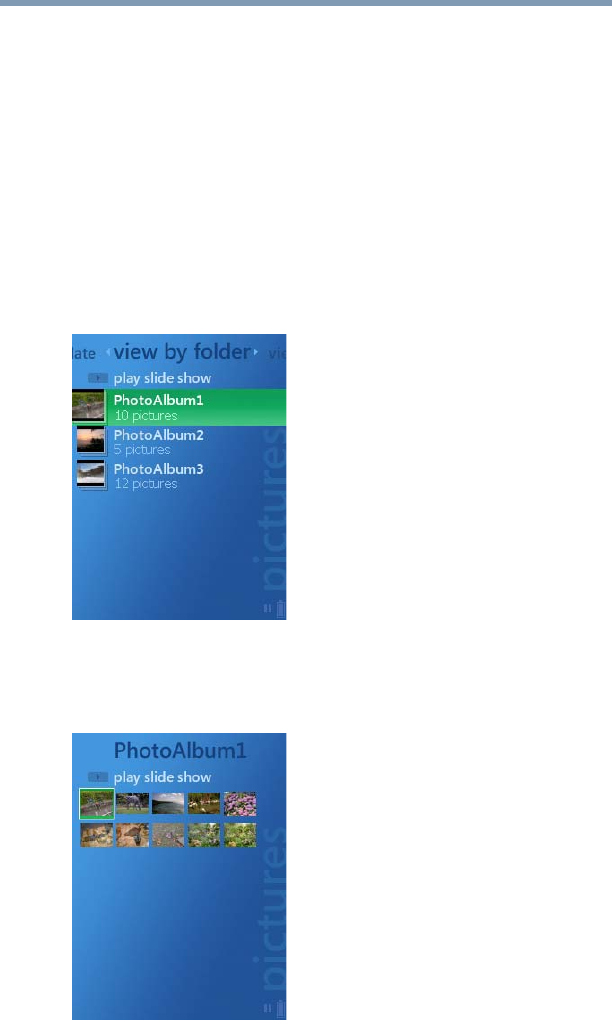
63
Photos and your gigabeat®
Viewing photos
Viewing photos
Viewing photos by folder
You can view the photo data transferred to the gigabeat® in units of
folders in which the data is saved.
1Select My Pictures on the start screen, and press the Enter
button.
2Press the Left or Right button to select View by Folder.
3Select the folder you want to view, and press the Enter button.
The photos contained in the selected folder will be shown in
thumbnails.
(Sample Image)
4Select the photo you want to view, and press the Enter button.
The selected photo will be expanded to a full-screen view.
(Sample Image)
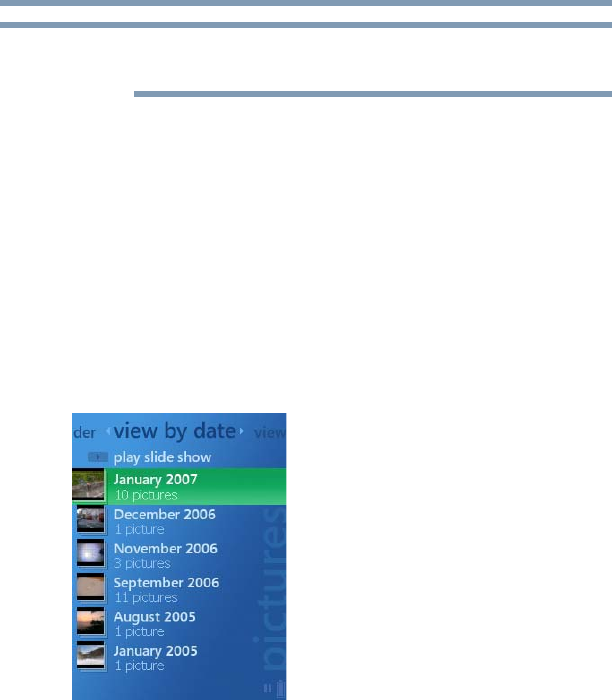
64 Photos and your gigabeat®
Viewing photos
You can also select a photo and press the Play/Pause button to
expand the selected photo to a full-screen view.
Viewing photos by date
You can view the photo data transferred to the gigabeat® in units of
groups classified by captured month and year.
1Select My Pictures on the start screen, and press the Enter
button.
2Press the Left or Right button to select View by Date.
3Select the group corresponding to the month and year of data
you want to view, and press the Enter button.
The photos belonging to the selected group will be shown in
thumbnails.
(Sample Image)
NOTE
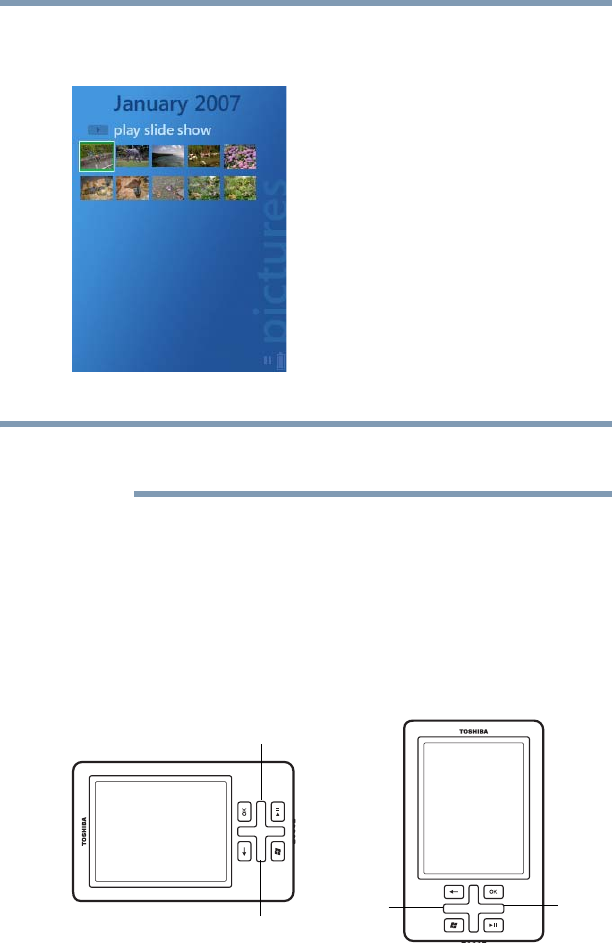
65
Photos and your gigabeat®
Changing photos
4Select the photo you want to view, and press the Enter button.
The selected photo will be expanded to a full-screen view.
(Sample Image)
Photo data of unknown date of capture will be classified under the
Unknown Date/Time group.
Changing photos
Press the Left or Right button.
Left: The previous photo will be shown.
Right: The next photo will be shown.
With landscape photos, the Up/Down buttons will act as the
Left/Right buttons.
(Sample Illustration)
NOTE
Right
Left
RightLeft
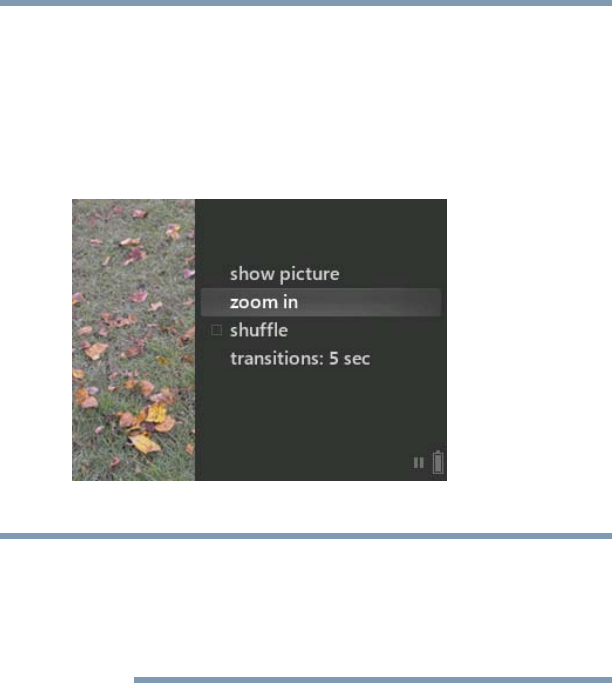
66 Photos and your gigabeat®
Changing photos
Zooming in
1While a photo is displayed, press the Enter button to open the
photo setting screen. .
2Select Zoom In, and press the Enter button.
Press the Enter button again, and the photo will return to its
original size.
(Sample Image)
❖You cannot zoom in on a photo with a data size that is 320 x
240 pixels or smaller.
❖You can press the Up, Down, Left or Right buttons while
zooming in on a photo to move the zoomed-in area up or down
or to the left or right.
NOTE
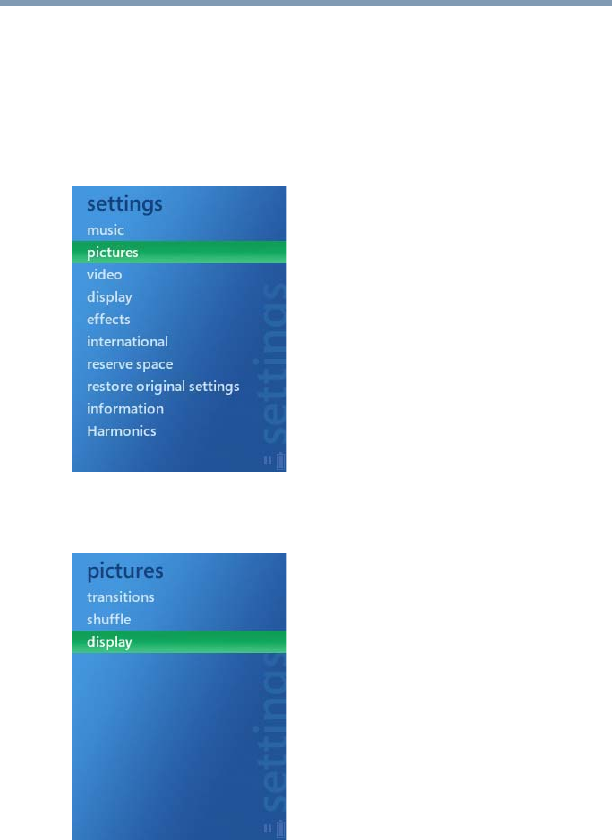
67
Photos and your gigabeat®
Changing photos
Changing the orientation
1Press the Quick button, and select Start.
The start screen will appear.
2Select Settings, and press the Enter button.
3Select Image, and press the Enter button.
(Sample Image)
4Select Screen, and press the Enter button.
(Sample Image)
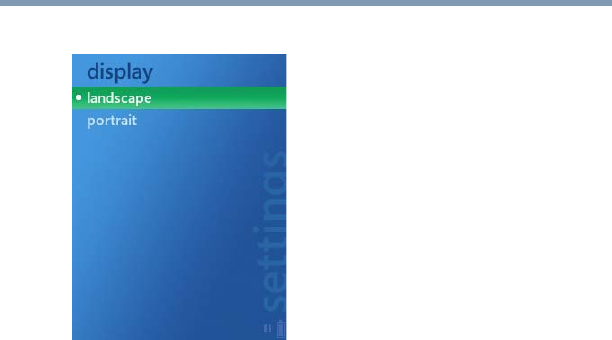
68 Photos and your gigabeat®
Showing photo information and music information
5Select Portrait or Landscape, and press the Enter button.
(Sample Image)
6Press the Back button to return to the photo display screen.
The photo is now displayed in the specified orientation.
Showing photo information and music information
1Press the Enter button while a photo is displayed.
The photo setting screen will appear.
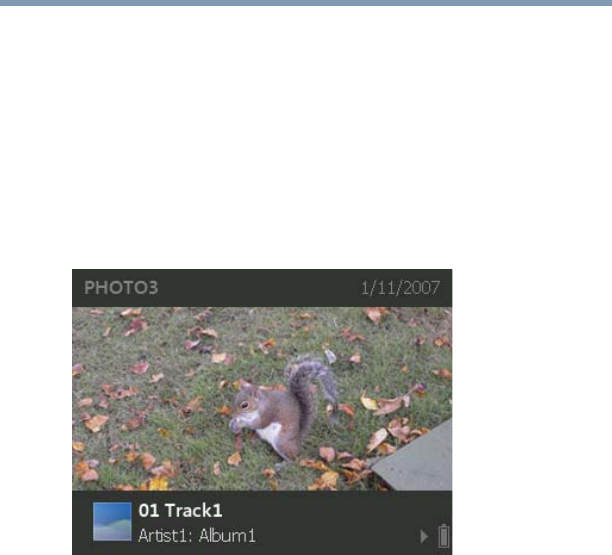
69
Photos and your gigabeat®
Viewing a slide show
2Select Photo Information, and press the Enter button
The photo information screen will appear.
Press the Enter button again, and the display will return to the
normal photo display screen.
The information (name and date) of the photo currently
displayed is shown, along with the play/pause icon and battery
icon.
If music is currently playing, the information of the applicable
song is also shown.
(Sample Image)
Viewing a slide show
Playing a slide show
You can view a slide show of photo data you have transferred to the
gigabeat®.
A slide show can also be played while music is playing.
1Select My Pictures on the start screen, and press the Enter
button.
2Press the Left or Right button to select View by Folder or
View by Date.
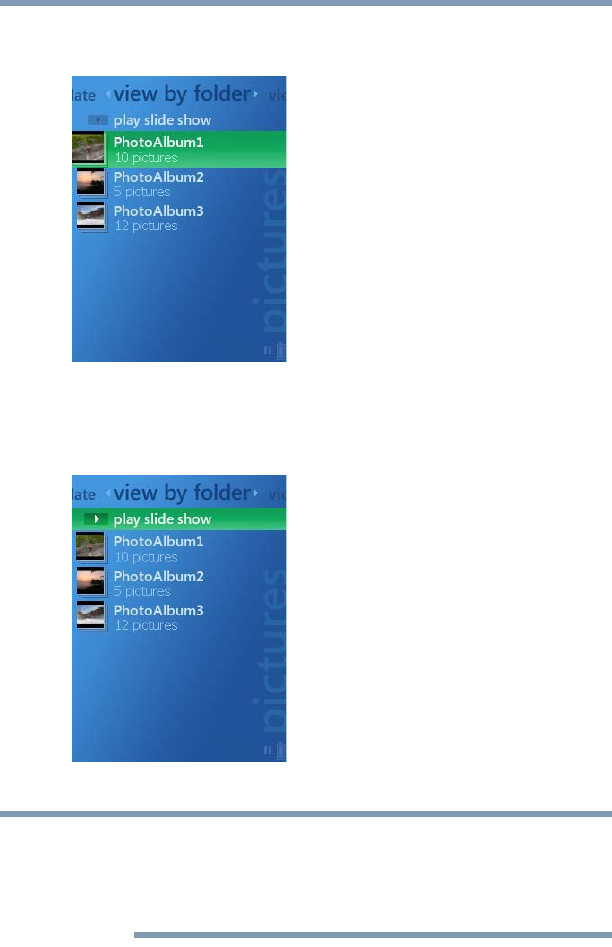
70 Photos and your gigabeat®
Viewing a slide show
3Select the folder or date-selected group containing the photos
you want to view in a slide show.
(Sample Image)
4Select Slide Show, and press the Enter button.
All photos in the selected group will be shown in a slide show.
(Sample Image)
❖You can also select a group and press the Play/Pause button
to play a slide show of the photos in the selected group.
❖Selecting Slide Show immediately below View by Folder
or View by Date will play a slide show of all photo data.
NOTE
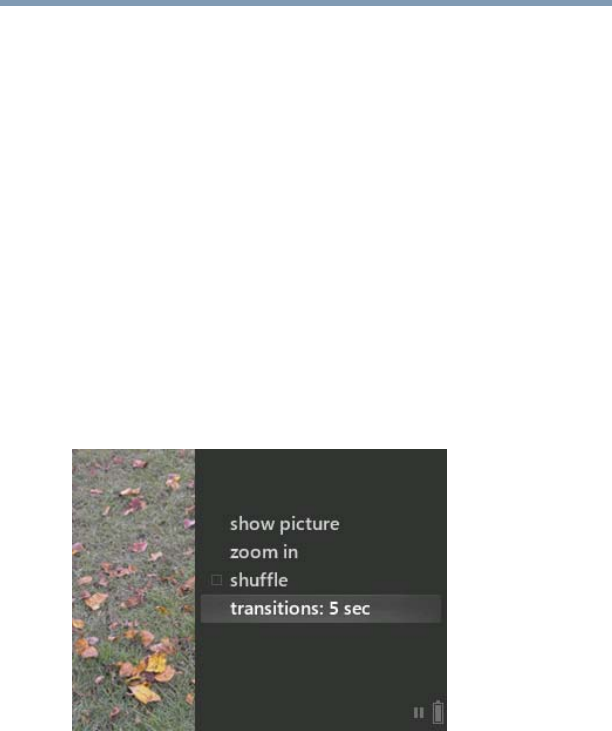
71
Photos and your gigabeat®
Viewing a slide show
Stopping the slide show
Press the Play/Pause button.
Press the button again, and the slide show will resume.
If the Play/Pause button is pressed while musing is playing, both
the slide show and music will stop.
You can also change the display during a slide show by pressing the
Left or Right button.
Refer to “Changing photos ” on page 65.
Changing the slide show interval
You can set how many seconds each photo will be shown in a slide
show.
1While a slide show is playing, press the Enter button to open
the photo setting screen. .
2Select the Interval line.
(Sample Image)
3Press the Enter button, and select a desired display time.
Every time the Enter button is pressed, the selected time will
change in the sequence of 3 Sec,5 Sec,7 Sec,10 Sec,15 Sec
and 30 Sec.
4Select View Image and press the Enter button.
The display will return to the slide show screen.
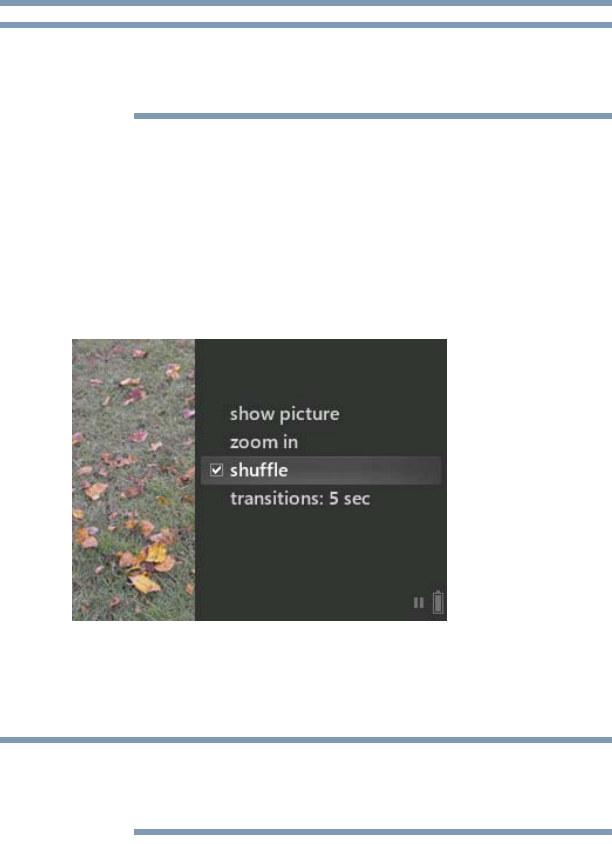
72 Photos and your gigabeat®
Viewing a slide show
You can also set the display interval when a slide show is not
playing. Select Settings ÆImage ÆChange from the start
screen to set a desired interval.
Play a random slide show
You can view photos in a different sequence in a slide show.
1While a slide show is playing, press the Enter button to open
the photo setting screen.
2Select Random, and press the Enter button.
The check box will be selected.
(Sample Image)
3Select View Image, and press the Enter button.
The display will return to the previous screen.
You can also set the random mode when a slide show is not playing.
Select Settings ÆImage ÆRandom from the start screen to set
the random mode.
NOTE
NOTE

73
Photos and your gigabeat®
Deleting photos
Deleting photos
To delete photo data saved in the gigabeat®, delete the same data in
Windows Media® Player 11 or 10.
The following steps assume that Windows Media® Player 11 is
used. If you are using Windows Media® Player 10, refer to the
Windows Media® Player 10 Help file.
1Connect your computer and the gigabeat® using the USB cable.
2Start Windows Media® Player 11.
3Click the Synchronization tab, click the Category Selection
button, and select Image.
4Click the Synchronization tab, and select the gigabeat T
library in the tree shown on the left.
The library in the gigabeat® will be shown.
5Right-click the photo data you want to delete, and select Delete
in the displayed menu.
A dialog box to confirm the deletion will appear.
(Sample Image)
6Select Ye s .
The selected photo data will be deleted from the gigabeat®.
7After confirming that the photo data has been deleted, unplug
the USB cable.
PLACE HOLDER

74
Chapter 4
Video and your gigabeat®
Transferring video data
You can transfer video data from your computer to the gigabeat®
using Windows Media® Player 11 or 10.
Do not prepare WMV files larger than 4 GB.
The following steps assume that Windows Media® Player 11 is
used. If you are using Windows Media® Player 10, refer to the
Windows Media® Player 10 Help file.
1Connect your computer and the gigabeat® using the USB cable.
A screen will appear where you can select what will happen
every time the gigabeat® is connected.

75
Video and your gigabeat®
2Select Synchronize media files to this device using Windows
Media Player, and click OK.
If you want to automatically start Windows Media® Player 11
without showing this screen every time the gigabeat® is
connected from now on, select the Always perform the
selected action check box.
Windows Media® Player 11 will start and the device setting
screen will appear.
(Sample Image)
3Click Finish or Cancel.
Clicking the Cancel button will let you transfer data manually
to the gigabeat®.
Proceed to step 4.
Clicking the Finish button will start transfer (synchronization).
Every time the gigabeat® is connected to your computer, the
two will be synchronized automatically and data will be
transferred to the gigabeat®.
This screen will not be displayed if the above setting is already
done. You can set automatic synchronization by clicking below
PLACE HOLDER

76 Video and your gigabeat®
the Synchronization tab, selecting gigabeat T selecting
Synchronization Settings, and setting desired items.
(Sample Image)
4Click the Synchronization tab in Windows Media® Player 11,
click the Category Selection button, and select Video.
Select desired data from the tree view in Windows Media®
Player 11.
5Right-click the data you want to transfer (synchronize), and
select Add to “Synchronization List” in the displayed short-
cut menu.
The data will be added to the synchronization list on the right
side of the screen.
You can also drag and drop the data to the synchronization list
area on the right to add the data to the synchronization list.
(Sample Image)
PLACE HOLDER
PLACE HOLDER

77
Video and your gigabeat®
6Click the Synchronize button in the bottom right-hand corner.
Synchronization will start.
While data is being synchronized, the Synchronize button
changes to the Stop button. Once the synchronization is
finished, the button text will change to Synchronize again.
For details, refer to the Windows Media® Player 11 Help file.
(Sample Image)
The gigabeat® may not be able to play WMV files containing data
that is copyright-protected by Windows Media® DRM10, in which
case one of the following error messages may appear:
1) “The data has expired.” (The period during which the data can be
played has expired and consequently the data cannot be played.
You must renew the subscription on a computer subscribing to
the applicable WMV data, and connect the gigabeat® to and
synchronize it with your computer.)
2) “Synchronize the gigabeat® with the computer.” (This message is
displayed when the gigabeat® has not been connected to your
computer for some time. If this message appears, connect the
gigabeat® to your computer via USB and synchronize it with
Windows Media® Player 11 or 10. The gigabeat® should be able
to play the data. This error message may also be displayed when
the applicable data has expired. In this case, take the action
explained in 1).
❖Depending on their format, some WMV files may be converted
to a gigabeat®-supporting format when the files are transferred
to the gigabeat®. WMV data transferred in Windows Explorer
PLACE HOLDER
NOTE

78 Video and your gigabeat®
Viewing video
are not converted to a gigabeat®-supporting format, and
therefore skipped frames may occur during playback.
❖Large files that exceed 2 GB in size or recording time exceeds
9 hours 6 minutes cannot be played properly on the gigabeat®.
❖Always use Windows Media® Player 11 or 10 when
transferring data to the gigabeat®. Never use any other method
of transfer.
Viewing video
Playing selected video data
You can select desired video data “by date,” “by name” or “by
source” based on the video data information that has been
transferred to the gigabeat®.
1Select My Video on the start screen, and press the Enter
button.
2Press the Left or Right button to select By Date,By Source or
By Name.
3Select the video you want to play, and press the Enter button.
A screen showing the title of the selected video will appear.
If station name information is appended to the video data, the
station name information will be shown as the source
information. If station name information is not appended to the
video, “Unknown Source” will be shown.
(Sample Image)
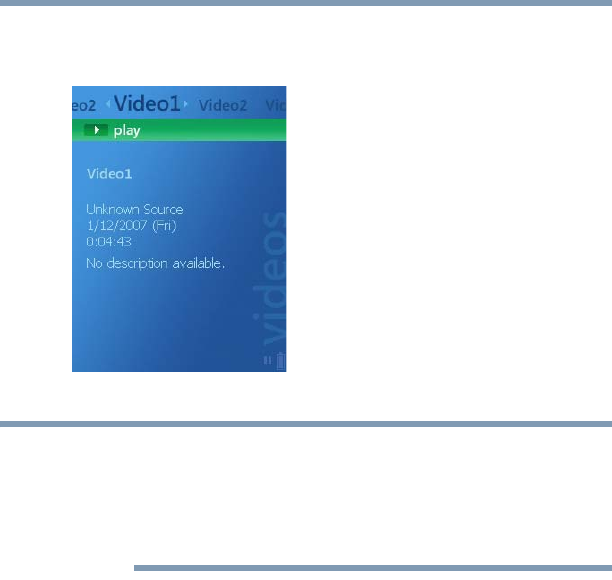
79
Video and your gigabeat®
Functions available during playback
4Select Play, and press the Enter button.
Playback will start.
(Sample Image)
❖You can also select a desired video and press the Play/Pause
button to play the video.
❖If the video is paused in the middle, the elapsed time bar will
be shown for several seconds at the bottom of the playback
screen.
Functions available during playback
Adjusting the volume
Press the Up or Down button while the playback screen is
displayed.
The volume will be shown for approximately 1 second, and the
volume will change every time a button is pressed.
Pausing
Press the Play/Pause button.
Or, press the Enter button.
Press the button again, and the remainder of the video will be
played.
NOTE
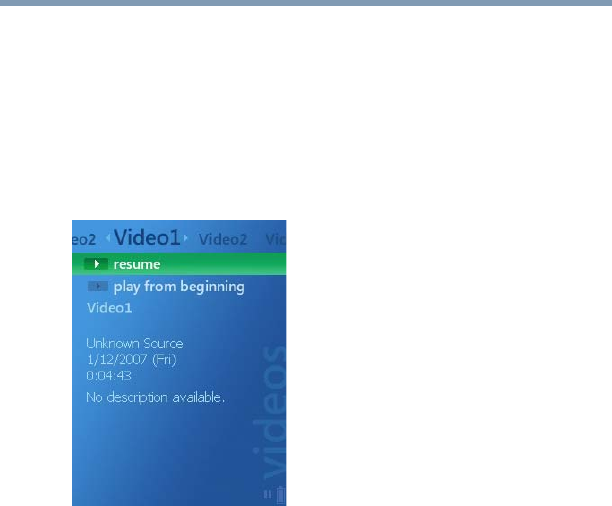
80 Video and your gigabeat®
Functions available during playback
Resuming the playback/playing from the beginning
If the video was stopped in the middle, you can play the video from
the point at which the playback was stopped, or from the beginning.
1Return to the screen showing the title of the video data that was
playing.
2Select Resume or Play from Start, and press the Enter button
or Play/Pause button.
(Sample Image)
Fast rewinding/forwarding
Press the Left button.
The video will return to a position approximately 10 seconds
before.
Press and hold the button, and the gigabeat® will fast rewind
the data.
Press the Right button.
The video will advance to a position approximately 30 seconds
ahead.
Press and hold the button, and the gigabeat® will fast forward
the data.
When the button is released, the video will be played from the
position achieved by fast rewinding/forwarding.
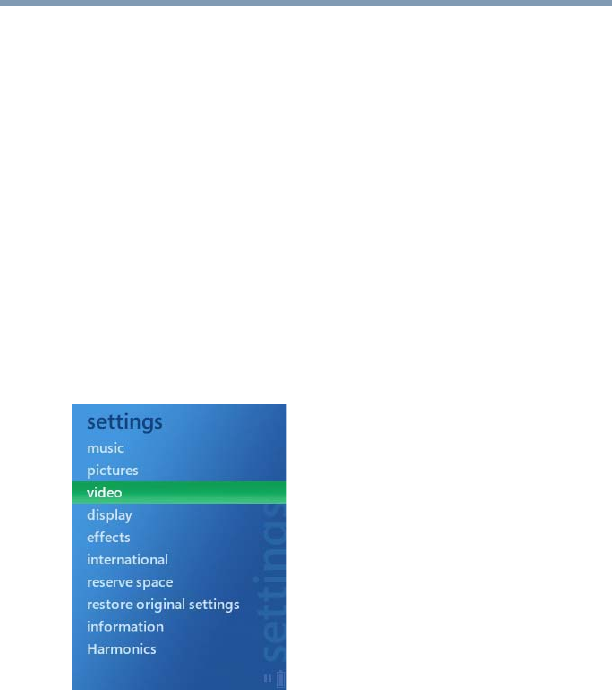
81
Video and your gigabeat®
Functions available during playback
Displaying the start screen
To use a different function, display the start screen and select a
different menu.
Press the Start button.
The video will pause and the start screen will appear.
Press the button again, and the start screen will disappear and the
playback will resume.
Changing the orientation
1Press the Start button.
The video will pause and the start screen will appear.
2Select Settings, and press the Enter button.
3Select Video, and press the Enter button.
(Sample Image)
4Select Screen, and press the Enter button.
5Select Portrait or Landscape, and press the Enter button.
6Press the Back button to return to the video playback screen.
The video will be played in the specified orientation.
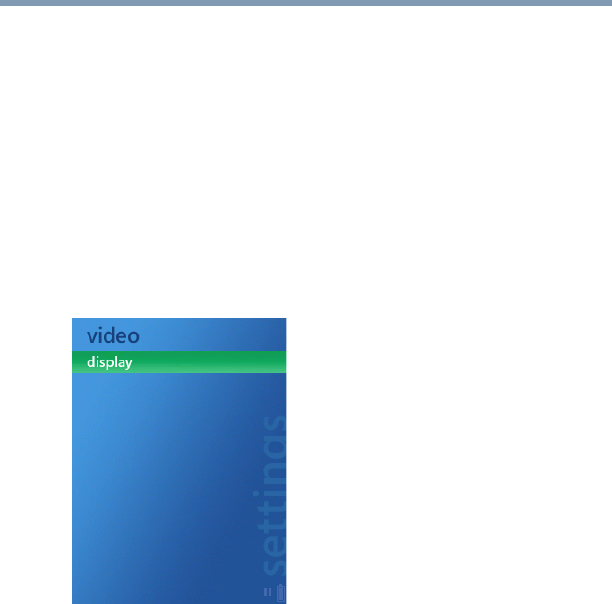
82 Video and your gigabeat®
Deleting video data
Deleting video data
You can delete video data from the gigabeat® by following the same
steps explained in “Deleting music data ” on page 53.
1Connect your computer and gigabeat® using the USB cable.
2Start Windows Media® Player 11.
3Click the Synchronization tab, click the Category Selection
button, and select Video.
4Click the Synchronization tab, and click the gigabeat T
library in the tree shown on the left.
The library in the gigabeat® will be shown.
(Sample Image)
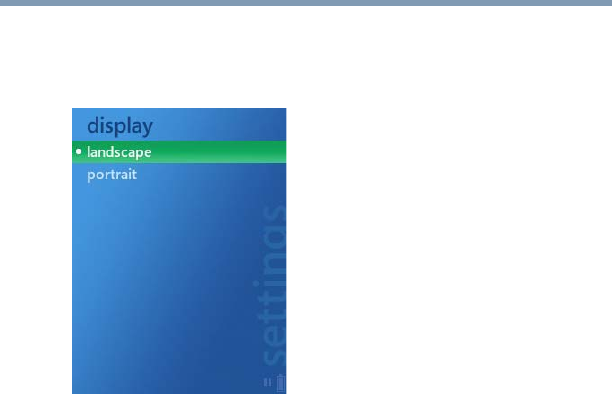
83
Video and your gigabeat®
Deleting video data
5Right-click the video data you want to delete, and select Delete
in the displayed menu.
A dialog box to confirm the deletion will appear.
(Sample Image)
6Select Ye s .
The selected video data will be deleted from the gigabeat®.
7After confirming that the video data has been deleted, unplug
the USB cable.

84
Chapter 5
TV and your gigabeat®
Preparing TV program data
Transferring recorded TV programs
You can use Windows Media® Player 11 or 10 to transfer to
(synchronize with) your gigabeat® the TV programs you have
recorded with Windows XP Media Center Edition 2005 or later or
Windows Media® Center1.
The transfer steps are the same as those explained in “Transferring
video data ” on page 74.
The only difference is that you must select Recorded TV in step 4.
4Click the Synchronization tab in Windows Media® Player 11,
click the Category Selection button, and select Recorded TV.

85
TV and your gigabeat®
Viewing recorded TV programs
❖If you are using Windows Media® Player 10, refer to Help in
Windows Media® Player 10.
❖You can also transfer recorded TV programs to (synchronize
them with) the gigabeat® using Windows XP Media Center
Edition 2005 or later or Windows Media Center1. For
information on how to transfer TV programs, refer to Help in
each application.
❖Large files that exceed 2 GB in size or recording time exceeds
9 hours 6 minutes cannot be played properly on the gigabeat®.
1. Windows Media Center is included in Windows Vista® Home Premium or
Windows Vista® Ultimate.
Viewing recorded TV programs
Playing a selected TV program
You can select a desired TV program “by date” or “by name” based
on the TV program information that has been transferred to the
gigabeat®.
1Select My TV on the start screen, and press the Enter button.
2Press the Left or Right button to select By Date or By Name.
3Select the TV program you want to play, and press the Enter
button.
A screen showing the title of the selected TV program will
appear.
(Sample Image)
NOTE
PLACE HOLDER

86 TV and your gigabeat®
Viewing recorded TV programs
4Select Play, and press the Enter button.
Playback will start.
(Sample Image)
❖Only data recorded with Windows XP Media Center Edition
2005 or later or Windows Media Center are registered in My
TV. All other videos are registered in My Video.
❖To select data you have played before, select Resume or
Play from Start in step 4.
❖If the program is paused in the middle, the elapsed time bar
will be shown for several seconds at the bottom of the
playback screen.
Functions available during playback
The same functions available while a TV program is playing are the
same as those available while a video is playing.
Refer to “Functions available during playback ” on page 79.
PLACE HOLDER
NOTE

87
Chapter 6
Podcasts and your
gigabeat®
About the Wireless LAN function
You can connect the gigabeat® to your wireless LAN access point to
access the Internet and download podcast content.
A “Podcast” is an audio distribution service using the RSS (Really
Simple Syndication) technology. You can access desired podcast
sites (network radio programs, blogs, etc.) and download content.
❖Connection specifications
Applicable standard: IEEE 802.11 b/g
Encryption methods: WEP, TKIP, AES
Access method: Infrastructure
Notes on security when Wireless LAN products are used
A wireless LAN allows the user to exchange information between a
computer or other device and a wireless LAN access point using
radio waves, instead of using a LAN cable. Accordingly, the user
can access the LAN any time and anywhere within the service area.
However, radio waves transmit through structures (walls, etc.) and
reach all locations within the specified service area, which gives
rise to the following risks if security measures are not taken:

88 Podcasts and your gigabeat®
Setting up a Wireless LAN connection
❖Communication data gets stolen
An unauthorized individual may intentionally intercept radio
waves and steal communication data, such as the following:
❖ID, password, credit card number and other personal
information
❖E-mail contents
❖Illegal accesses
An unauthorized individual may access a private or company
network without authorization and carry out the following acts:
❖Retrieve personal information or confidential information
(divulgement of information)
❖Pretend to be someone else and communicate or distribute
illegal information (spoofing)
❖Intercept and modify communication data and send
modified information (alteration)
❖Send computer viruses to damage data and systems
(sabotage)
Wireless LAN cards and wireless LAN access points normally
incorporate security features to address these problems. By using
each wireless LAN product after properly setting its security
function, you can reduce the risks of the above problems occurring.
TOSHIBA recommends that the user fully understand the
consequences of not setting the security function properly, and use
each product after setting its security function at the user’s own
discretion and responsibility.
Setting up a Wireless LAN connection
The following settings are necessary to connect the gigabeat® to
your access point or wireless LAN router (access point with router
function).
The example explained in this manual applies to gigabeat®
connection to an “access point.”

89
Podcasts and your gigabeat®
Setting up a Wireless LAN connection
Connection example
(Sample Illustration)
Preparation
❖Prepare the access point for network connection beforehand.
❖For the access point settings, refer to the owner's manual that
came with your access point.
1Select podcast on the start screen, and press the Enter button.
The podcast menu screen will appear.
2Select Settings, and press the Enter button.
A screen showing a list of connection settings will appear.
3Select Available Network, and press the Enter button.
Search will start and a list of access points found by the search
will be displayed.
4Select your access point (SSID), and press the Enter button.
The connection setting screen will appear.
gigabeat®Access point Modem InternetRouter

90 Podcasts and your gigabeat®
Setting up a Wireless LAN connection
5Specify the connection settings.
Enter the same encryption settings and encryption key as those
specified for your access point.
Network Name Enter the same network name (SSID) as your access
point.
Security Type Select an authentication method. It should be the same as
the authentication method set for the access point.
No Authentication (Open System): Authentication is
not performed.
Common Key: WEP authentication method WPA
Personal: WPA authentication method
WPA2 Personal: WPA2 authentication method
Encryption type Select an encryption method: It should be the same as the
encryption method set for the access point.
None: Encryption is not performed.
WEP: WEP encryption method
TKIP: TKIP encryption method
AES: AES encryption method
Network Security Key Enter a security key. Enter the same key set for the access
point.
For information on how to enter a security key, refer to
“How to enter from the keyboard screen” on page 91.
Key Index If WEP has been selected, select 1,2,3 or 4. The key
index should be the same as the one set for the access
point.
Proxy Enter a proxy. For information on how to enter a proxy,
refer to “How to enter from the keyboard screen” on
page 91.
Automatically Acquire
IP Address
Ye s : Select this option if the access point supports DHCP.
When this option is set, an IP address will be assigned
automatically.
No: Select this option if the access point does not support
DHCP. When No is selected, set the IP Address, Subnet
Mask, Default Gateway and Automatically Acquire DNS
Server Address fields.

91
Podcasts and your gigabeat®
Setting up a Wireless LAN connection
6Select the Apply button at the bottom of the screen, and press
the Enter button.
The access point you have set will be registered in the
gigabeat®.
❖In certain situations, such as when you cannot find the network
name (SSID) by search, you can manually register the name of
the network you want to connect to. In step 3, select Manual
Settings and enter the desired network name and applicable
encryption method, etc., on the displayed connection setting
screen.
❖You can display up to five network names that have been
registered most recently, on the screen showing the list of
wireless LAN connection settings in step 2.
❖The MAC address of the gigabeat® can be set in the following
manner:
Select podcast on the start screen, press the Enter button,
select Information, and press the Enter button.
How to enter from the keyboard screen
1Press the Up/Down/Left/Right buttons to select a desired key
on the screen, and press the Enter button.
The applicable character will be entered in the text display
field.
2Enter the next character in the same manner as explained in
step 1.
3When all characters have been entered, press the
Up/Down/Left/Right buttons to select OK on the screen, and
press the Enter button.
Deleting a registered access point
1Select podcast on the start screen, and press the Enter button.
The podcast menu screen will appear.
2Select Settings, and press the Enter button.
A screen showing a list of connection settings will appear.
DNS Server Set this item only when you have selected No under
Automatically Acquire DNS Server Address.
NOTE

92 Podcasts and your gigabeat®
Setting up a Wireless LAN connection
3Select the network name you want to delete, and press the Left
button.
The quick menu will appear.
4Select Delete, and press the Enter button.
A dialog box to confirm the deletion will appear.
5Select Ye s , and press the Enter button.
The selected network name will be deleted.
Modifying a registered access point
1Select podcast on the start screen, and press the Enter button.
The podcast menu screen will appear.
2Select Settings, and press the Enter button.
A screen showing a list of connection settings will appear.
3Select the network name you want to modify, and press the
Left button.
The quick menu will appear.
4Select Edit, and press the Enter button.
The connection setting screen will appear.
5Modify the settings as necessary, and press the Enter button.
The modified settings will be registered.
Keeping the Wireless LAN power always on
You can keep the wireless LAN power always on. Since the power
is always turned on, you can connect to the network quickly after
the wireless LAN function is started.
1Select podcast on the start screen, and press the Enter button.
The podcast menu screen will appear.
2Select Wireless Power, and press the Enter button.
A screen showing the wireless power settings will appear.
3Select Always On, and press the Enter button.
The wireless LAN power will always remain on from now on.
If you do not want to keep the wireless LAN power always on,
reset the power mode to Only Wireless Accessing.

93
Podcasts and your gigabeat®
Setting up a Wireless LAN connection
Registering a podcast site
To download content from a podcast site, you must register the
podcast site first.
❖Set up a wireless LAN connection beforehand. Refer to
“Setting up a Wireless LAN connection ” on page 88.
1Select podcast on the start screen, and press the Enter button.
The podcast menu screen will appear.
2Select podcast, and press the Enter button.
A screen showing a list of podcast directories will appear.
3Select Directory, and press the Enter button.
The access point selection screen will appear.
4Select the access point you want to connect to, and press the
Enter button.
The gigabeat® will connect to the network, download the
podcast list, and open the category selection screen.
5Select a desired category, and press the Enter button.
A screen will appear where you can select podcast sites for the
selected category.
6Select the podcast site you want to register, and press the Enter
button.
A dialog box to confirm the registration will appear.
7Select Ye s , and press the Enter button.
The selected podcast site will be registered, and the display
will return to the podcast directory list screen. To download
podcast content, proceed to step 3 of “Downloading podcast
content ” on page 94.
Deleting a registered podcast site
1Select podcast on the start screen, and press the Enter button.
The podcast menu screen will appear.
2Select podcast, and press the Enter button.
A screen showing a list of podcast directories will appear.
3Select the podcast site you want to delete, and press the Left
button.
The quick menu will appear.

94 Podcasts and your gigabeat®
Setting up a Wireless LAN connection
4Select Delete Podcast, and press the Enter button.
A dialog box to confirm to confirm the deletion will appear.
5Select Ye s , and press the Enter button.
The selected podcast site will be deleted.
Downloading podcast content
You can access a registered podcast site and download desired
content.
1Select podcast on the start screen, and press the Enter button.
The podcast menu screen will appear.
2Select podcast, and press the Enter button.
A screen showing a list of podcast directories will appear.
3Select the podcast site you want to access, and press the Enter
button.
A screen showing a list of content available on the selected
podcast site will appear.
4Select the content you want to download, and press the Enter
button.
The access point selection screen will appear.
5Select the access point you want to connect to, and press the
Enter button.
The gigabeat® will connect to the network and start
downloading the content.
When the download is completed, a screen showing the
“Completed” message will appear.
6Press the Enter button.
❖To play the downloaded content, refer to “Playing podcast
content ” on page 95.
❖The content list can be updated to reflect the latest content.
Refer to “Updating the content list of a podcast site” on
page 95.
NOTE

95
Podcasts and your gigabeat®
Playing podcast content
Updating the content list of a podcast site
1Select podcast on the start screen, and press the Enter button.
The podcast menu screen will appear.
2Select podcast, and press the Enter button.
A screen showing a list of podcast directories will appear.
3Press the Left button
The quick menu will appear.
4Select Update Podcast or Update All Podcast, and press the
Enter button.
The gigabeat® will start updating the list data.
When the update is completed, a screen showing the
“Completed” message will appear.
Update Podcast: The content list of the selected podcast site
will be updated.
Update All Podcast: The content lists of all registered podcast
sites will be updated.
5Press the Enter button.
Playing podcast content
You can play podcast content that have been downloaded.
You can select desired songs from the downloaded podcast content
and listen to the selected songs by following the same steps
explained in “Listening to selected music ” on page 35.
❖Artist name: Podcast site name
❖Album name: Podcast site name
❖Song: Content name
1Select My Music on the start screen, and press the Enter
button.
2Press the Left or Right button to display the Genres screen.
3Select podcast, and press the Enter button.
4Select the name of the content you want to listen, and press the
Enter button.
You can deleted downloaded podcast content in the same manner as
you delete music data transferred with Windows Media® Player.
Refer to “Deleting music data ” on page 53.
NOTE

96
Chapter 7
gigabeat® Settings
Changing the gigabeat® display
Setting the backlight off time
You can set the length of time before the backlight of the screen
will automatically turn OFF if the gigabeat® is not operated.
Since the battery consumes less power when the backlight is turned
off, the continuous playback time of music, and other activities will
increase.
1Select Settings on the start screen, and press the Enter button.
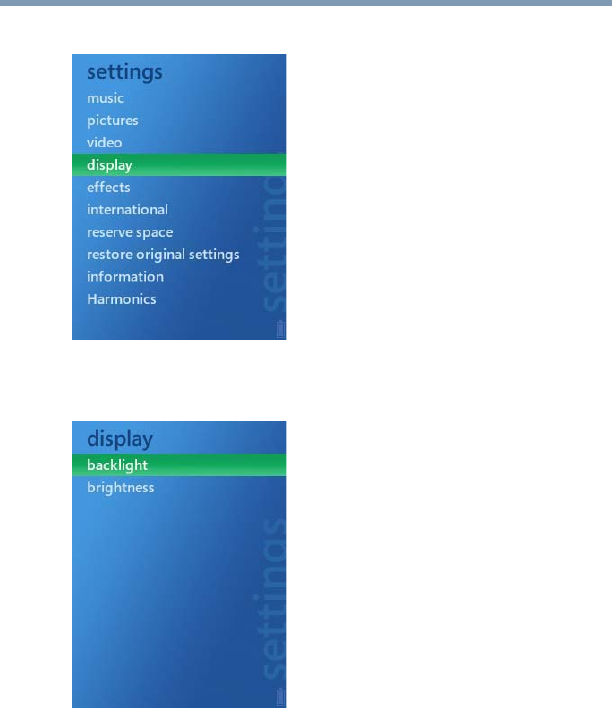
97
gigabeat® Settings
Changing the gigabeat® display
2Select Screen, then press the Enter button.
(Sample Image)
3Select Backlight, then press the Enter button.
(Sample Image)
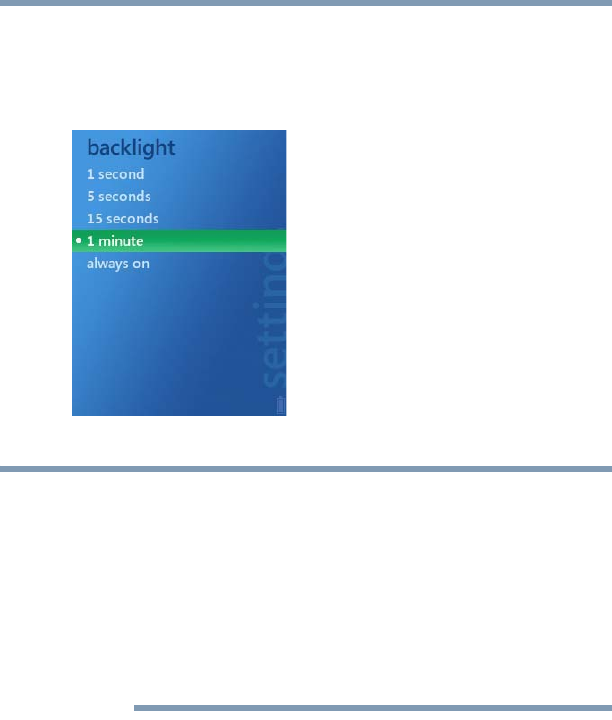
98 gigabeat® Settings
Changing the gigabeat® display
4Select the time the backlight will turn off if the gigabeat® is not
operated, then press the Enter button.
You can select of the following: 1 Sec, 5 Sec, 15 Sec, 1 Min, or
Always On
(Sample Image)
❖The backlight always remains on while a TV program, video or
slide show is playing.
❖Even when the backlight is set to Always On, the power will
turn OFF if the gigabeat® is not operated for approximately 10
minutes However, it will remain on when music is playing or
the USB connection is active.
❖If any button on the gigabeat® is pressed while the backlight is
turned off, the screen will turn on and the gigabeat® will accept
the applicable operation command.
NOTE
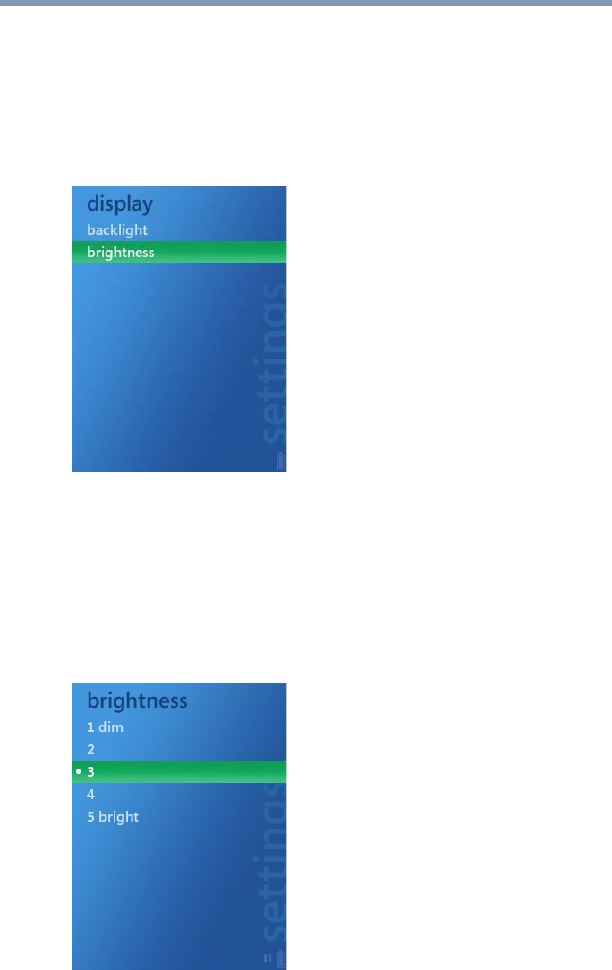
99
gigabeat® Settings
Changing the gigabeat® display
Changing the screen brightness
You can change the brightness of the gigabeat® screen.
1Select Settings on the start screen, and press the Enter button.
2Select Screen, and press the Enter button.
3Select Brightness, and press the Enter button.
(Sample Image)
4Select the brightness level you want to set, and press the Enter
button.
You can select from the following levels: 1: Darkest, 2, 3, 4,
5: Brightest
To check the actual brightness of each level by press the Up or
Down button to switch to the different levels.
(Sample Image)
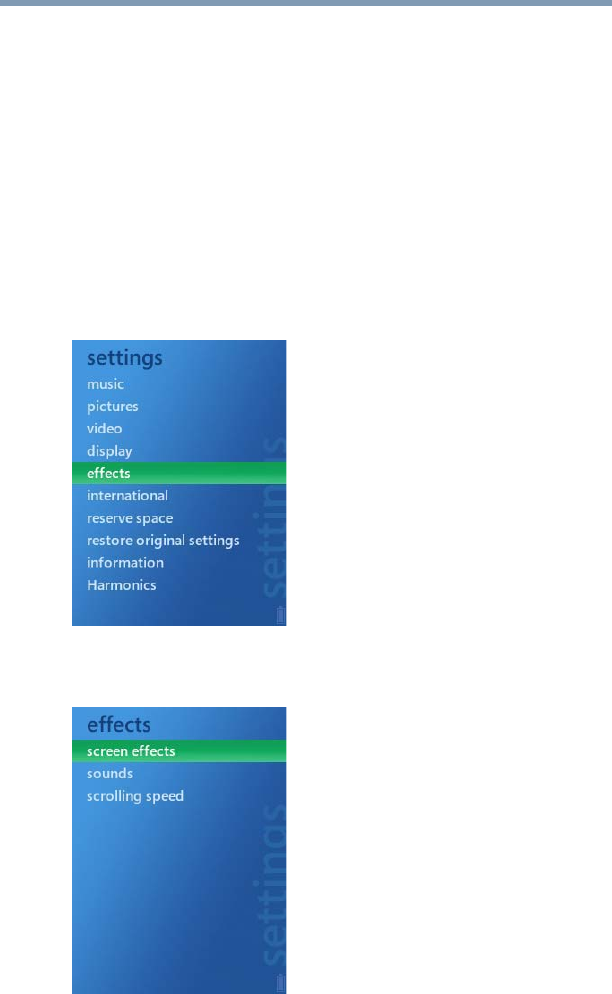
100 gigabeat® Settings
Changing the gigabeat® display
Adding effects
You can add effects, such as fade, slide and zoom, that will be
visible when navigating through the gigabeat® screens. The
applicable effects include the zoom-in/out effect that applies when
each item is selected on the menu screen, the fade-out/in effect that
applies when a music playback screen is displayed from the menu
screen, and the slide effect that applies when the Left or Right
button is pressed on a music playback screen to change to a
different playback screen.
To add the effects follow these steps:
1Select Settings on the Start screen, and press the Enter button.
2Select Effects, and press the Enter button.
(Sample Image)
3Select Screen Effects, and press the Enter button.
(Sample Image)
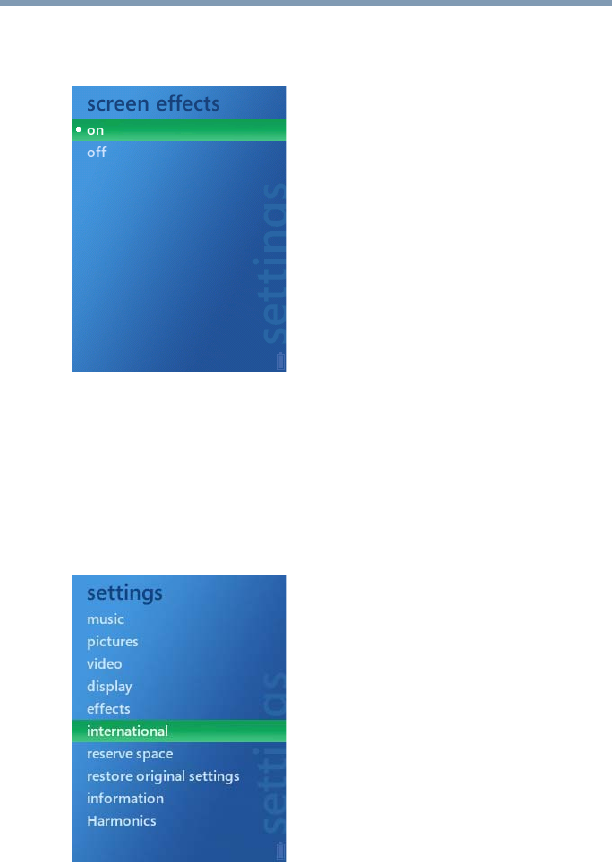
101
gigabeat® Settings
Changing the gigabeat® display
4Select On, and press the Enter button.
The effects will be enabled.
(Sample Image)
Setting a language/region
To change the language in which the gigabeat® screens are
displayed, follow these steps:
1Select Settings on the Start screen, and press the Enter button.
2Select International, and press the Enter button.
(Sample Image)
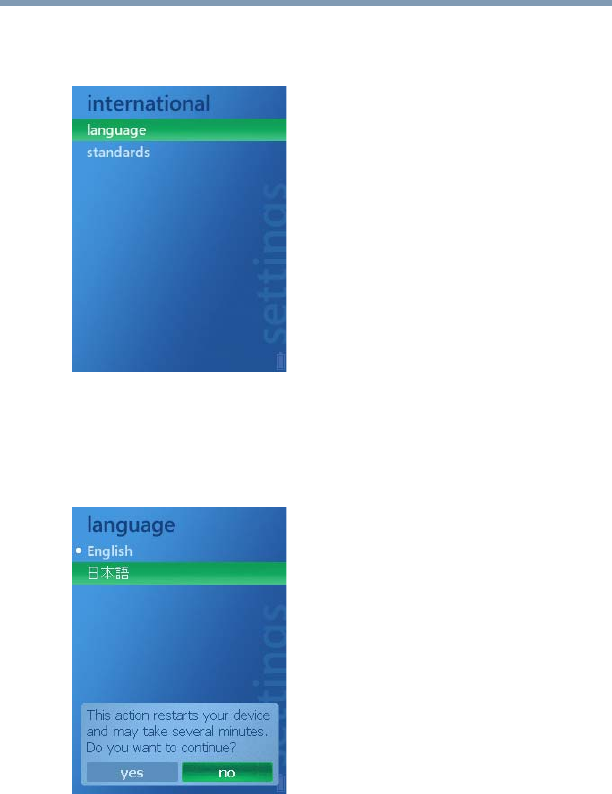
102 gigabeat® Settings
Changing the gigabeat® display
3Select Language, and press the Enter button.
A list of languages will appear.
(Sample Image)
4Select the language you want to use for the screen display, and
press the Enter button.
A confirmation message will appear.
(Sample Image)
5Press the Left or Right button to select Yes, then press the Enter
button.
The gigabeat® will restart and the display language will be
changed.
The regional setting (Standard setting) will also change
according to the selected language.
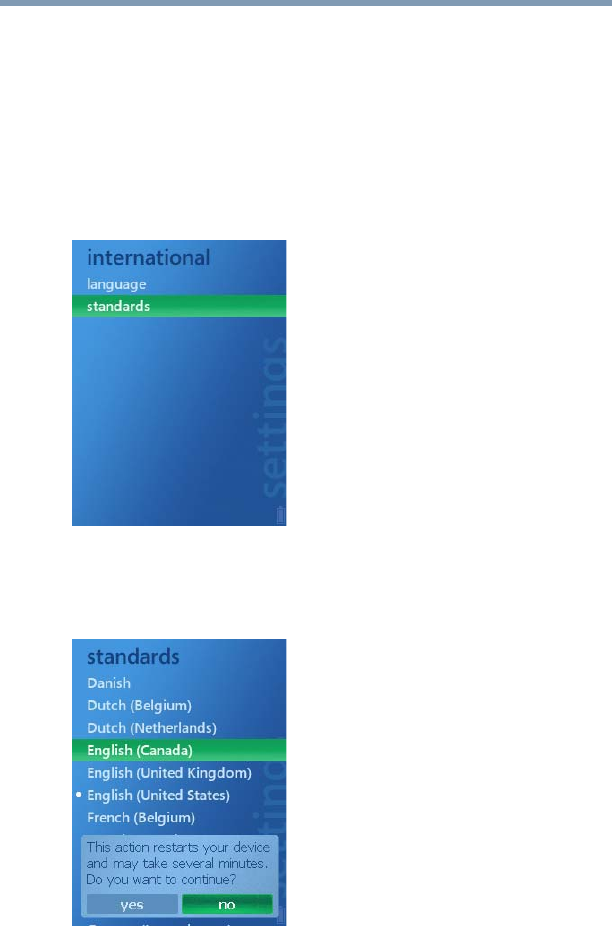
103
gigabeat® Settings
Changing the gigabeat® display
Changing the regional setting
You can also change the date/time and number display format that
are different from one region to another.
1Select Settings on the start screen, and press the Enter button.
2Select International, and press the Enter button.
3Select Standard, and press the Enter button.
A list of regions will appear.
(Sample Image)
4Select a desired region, and press the Enter button.
A confirmation message will appear.
(Sample Image)
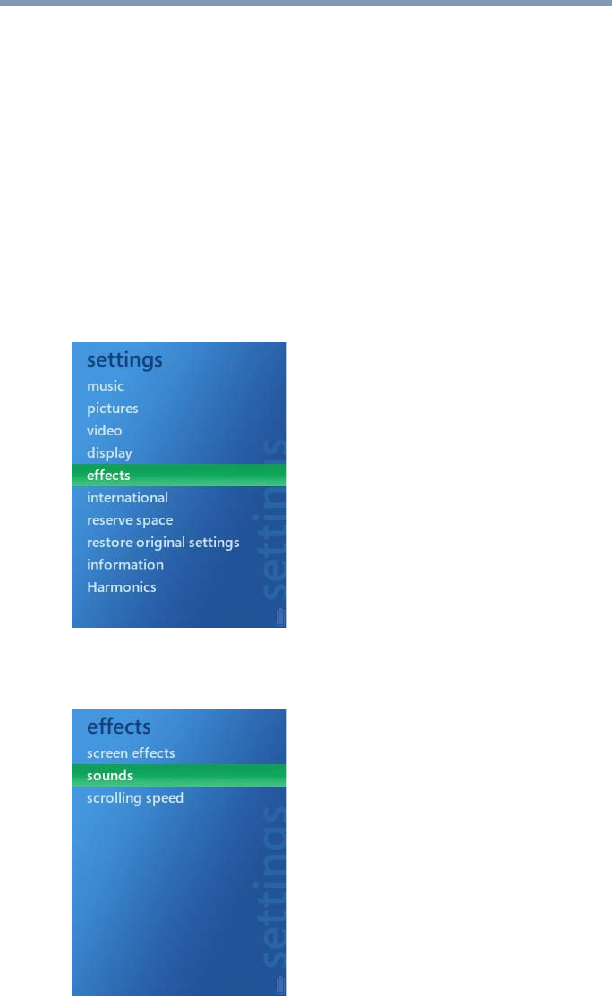
104 gigabeat® Settings
Changing the operation settings
5Press the Left or Right button to select Yes, and press the Enter
button.
The gigabeat® will restart and the date/time and display format
will be changed.
Changing the operation settings
Using sound effects
You can set the gigabeat® to output sound when various operations
are performed.
1Select Settings on the start screen, and press the Enter button.
2Select Effects, and press the Enter button.
(Sample Image)
3Select Sound, and press the Enter button.
(Sample Image)
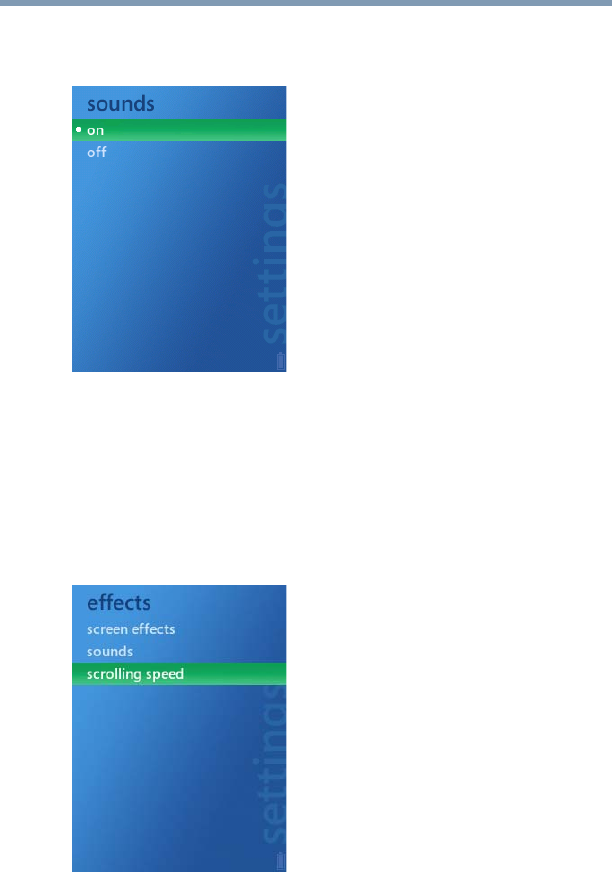
105
gigabeat® Settings
Changing the operation settings
4Select On, and press the Enter button.
To turn off sound effects, select Off, and press the Enter button.
(Sample Image)
Changing the scroll speed
You can also change the processing speed of gigabeat® operations.
1Select Settings on the start screen, and press the Enter button.
2Select Effects, and press the Enter button.
3Select Scroll Speed, and press the Enter button.
(Sample Image)
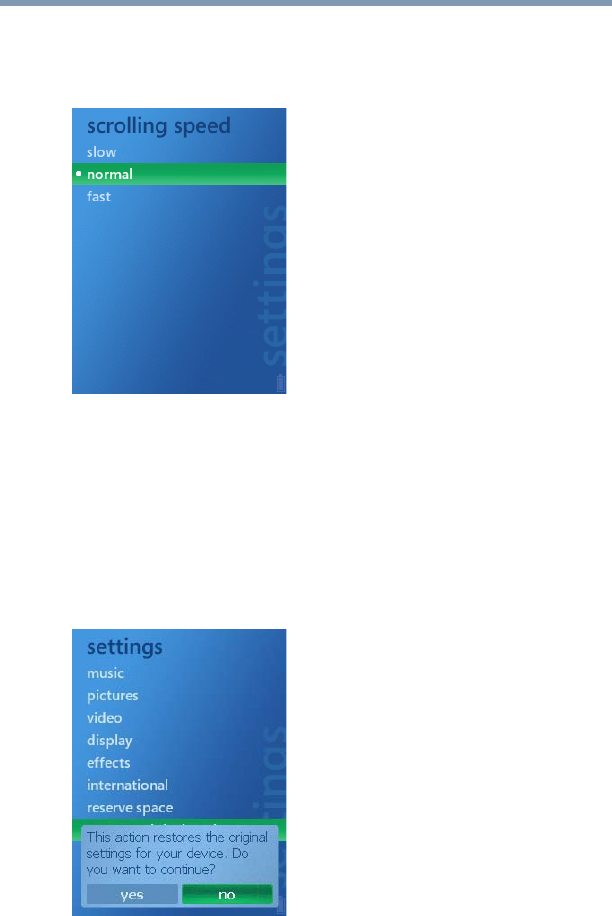
106 gigabeat® Settings
Changing the operation settings
4Select Low,Standard or High, and press the Enter button.
This option sets the processing speed that applies when menus
and items are selected.
(Sample Image)
Initializing the settings
You can clear the settings you have edited from the Settings menu
and revert all settings to their defaults.
1Select Settings on the start screen, and press the Enter button.
2Select Initialize, and press the Enter button.
A confirmation message will appear.
(Sample Image)
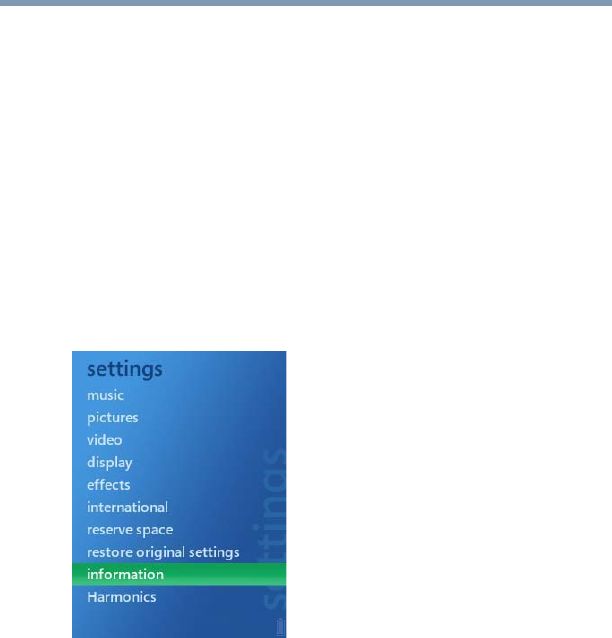
107
gigabeat® Settings
Changing the operation settings
3Press the Left or Right button to select Yes, and press the Enter
button.
A message will appear for several seconds, after which the
settings will return to their defaults.
Checking the gigabeat® information
To check the current information of your gigabeat®, follow the steps
below.
Note that you can only check these information and cannot change
any of the settings.
1Select Settings on the start screen, and press the Enter button.
2Select About gigabeat, and press the Enter button.
(Sample Image)
3Select Version,Content or Copyright Information, and press
the Enter button.
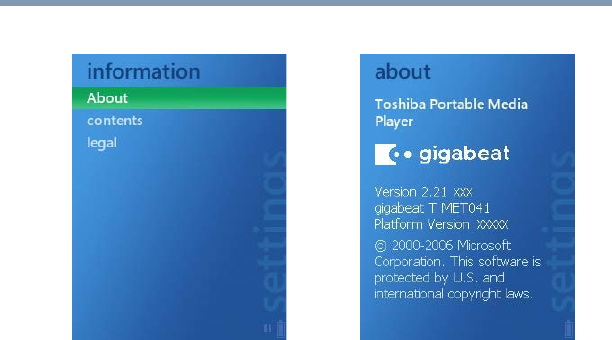
108 gigabeat® Settings
Changing the operation settings
4The selected information will be shown.
(Sample Image)

109
gigabeat® Settings
Menu list
Menu list
You can select the following menus on the start screen, which is
displayed by pressing the Quick button and then selecting Start.
The items denoted by • are selected by default.
My TV By Date
By Name
My Music Playlists
Songs
Genres
Albums
Artists
My Pictures View by Folder
View by Date
My Video By Date
By Source
By Name
podcast podcast
wireless power Always ON
Only wireless accessing
settings Available Network
Manual Settings
information Status

110 gigabeat® Settings
Menu list
Settings Music Random • Off
On
Continuous • Off
On
Equalizer • None
Acoustic
Classic
Electronic
Hip Hop
Jazz
Pop
Rock
Displayed Time • Elapsed Time
Remaining Time
Image Change 3 Sec
• 5 Sec
7 Sec
10 Sec
15 Sec
30 Sec
Random • Off
On
Screen • Landscape
Portrait
Video Screen • Landscape
Portrait
Screen Backlight 1 Sec
5 Sec
15 Sec
• 1 Min
Always On
Brightness 1: Darkest
2
• 3
4
5: Brightest

111
gigabeat® Settings
Menu list
Settings Effects Screen Effects • On
Off
Sound • On
Off
Scroll Speed Low
• Standard
High
International Language English
Francais
Japanese
Standard Dutch (Netherlands)
Dutch (Belgium)
Swedish
Spanish (Spain,
International Sort)
Danish
German (Austria)
German (Switzerland)
German (Germany)
German (Luxembourg)
French (Canada)
French (Switzerland)
French (France)
French (Belgium)
French (Luxembourg)
English (Canada)
English (U.K.)
English (U.S.)
Chinese (Taiwan)
Chinese (China)
Japanese
Reserve Space • None
256 MB
512 MB
1 GB
2 GTB

112 gigabeat® Settings
Menu list
Settings Initialize Yes
No
About gigabeat Version
Content
Copyright Information
Harmonics • Off
Professional
Dynamic

113
Chapter 8
If you have problems
Error messages
The following error messages may be displayed on the gigabeat®
screen. If any of these messages appear, take the applicable action.
If an error occurs, an applicable message will appear as shown
below. If you have encountered any of these messages, reset the
gigabeat®.
After a reset, the gigabeat® will display the start screen.
If the start screen is not displayed and the error message appears
again, contact the gigabeat® call center at 1-877-250-8595 or
1-949-583-3212 for assistance. Or, you can visit the Web site at
www.gigabeatsupport.toshiba.com.
Message Description and action
The specified item is not
found or cannot be played.
The data you are playing may have been deleted or
damaged. Transfer the data to the gigabeat® again.
The specified item does not
have a valid license.
The license of the data you are playing has expired.
Transfer the data to the gigabeat® again.
The gigabeat® will be
restarted to recover from an
error. All media items will
be deleted.
When the Enter button is pressed, formatting will
start and the gigabeat® will restart. Since the
gigabeat® memory is formatted, all files and recorded
programs you have transferred to the gigabeat® will
be removed.

114 If you have problems
Troubleshooting
Troubleshooting
Some problems you may encounter when using your gigabeat® are
relatively easy to identify and solve. This section covers problems
you may encounter and suggested actions.
Problem Cause Action Reference page
The gigabeat® does
not turn on, or does
not operate when
buttons are
pressed.
The remaining
battery power is
low.
Connect the
gigabeat® to a
computer using
the USB cable
and charge the
gigabeat®
battery.
See “Charging the
built-in battery” on
page 17.
The gigabeat® is
locked.
Release the Lock
switch to unlock
the gigabeat®.
See “Getting Started
with Your
gigabeat®” on
page 15.
The gigabeat® is
currently
connected to a
computer.
The gigabeat®
cannot be
operated while
being connected
to a computer.
See “Removing the
gigabeat® from
your computer” on
page 22.
Data cannot be
played.
Audio data is not
available.
Transfer audio
data to the
gigabeat® using
Windows
Media® Player
11 or 10.
See “Transferring
audio files on your
computer to the
gigabeat®” on
page 29.
No sound. The earbuds are
not connected
properly.
Check the
connection
between the
earbuds and
gigabeat®.
See “Listening to
music ” on page 35.
The volume is set
to the minimum
level.
Carefully, adjust
the volume.
See “Adjusting the
volume ” on
page 42.
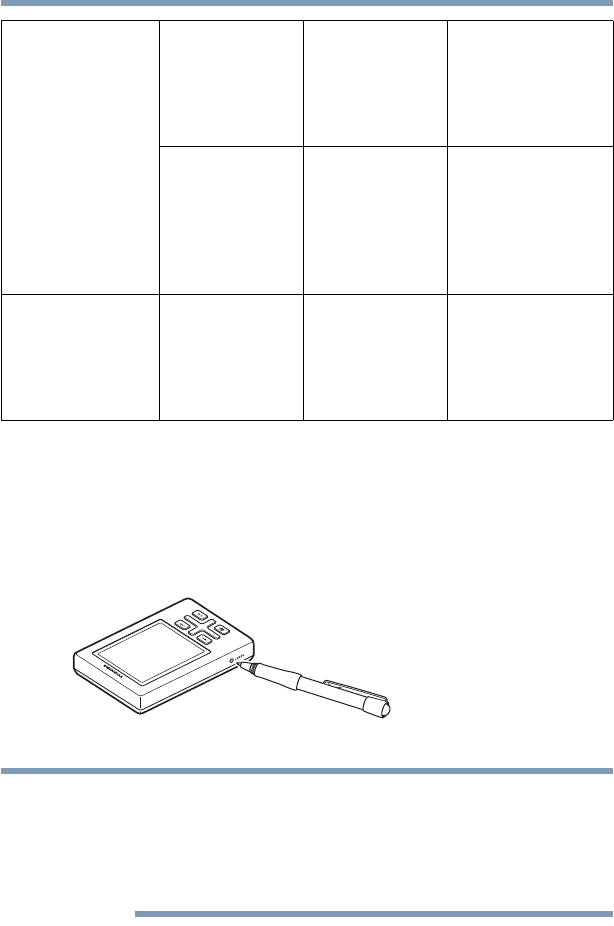
115
If you have problems
Resetting the gigabeat®
Resetting the gigabeat®
If the above actions do not resolve the problem, try resetting the
gigabeat®.
To reset the gigabeat®, press the reset switch located at the bottom
of the unit using a ballpoint pen or paperclip.
(Sample Illustration)
❖Resetting the gigabeat® will not initialize the settings. To
initialize the settings, select Settings then Initialize.
❖If subscription data cannot be played, connect the gigabeat® to
a computer and synchronize the gigabeat with Windows
Media® Player 11 or 10.
The “charging”
screen does not
appear even when
the gigabeat® is
charged.
The gigabeat® is
not connected
properly.
Check the
connection
between the
USB cable and
gigabeat®.
See “Connecting
your computer and
the gigabeat®” on
page 20.
The ambient
temperature is
outside the
specified range.
Charge the
gigabeat® at an
ambient
temperature
within the
specified range.
See “Charging the
built-in battery” on
page 17.
Your computer
does not recognize
the gigabeat®.
The gigabeat® is
not connected to
your computer
properly.
Check the
connection
between your
computer and
gigabeat®.
See “Connecting
your computer and
the gigabeat®” on
page 20.
NOTE

116 If you have problems
Frequently asked questions
Frequently asked questions
Q: Your computer does not recognize the gigabeat®.
A: The gigabeat® may not be recognized if it is connected to your
computer via a USB hub. Connect the gigabeat® to your computer
without using a USB hub.
Q: Audio data cannot be transferred to the gigabeat®.
A: Some audio data may not be playable on the gigabeat® and
cannot be transferred to the gigabeat®. For the types of audio data
playable on the gigabeat®, refer to “Combinations of Sampling
Frequencies and Bit Rates.”
Q: I have changed the gigabeat® display language, but I do not
know how to change it back to the original setting.
A: Select the previous language by following the steps below:
1Press the Start button to display the start screen.
2Select the last item, and press the Enter button.
3Select the sixth item from the top, and press the Enter button.
4Select the top item, and press the Enter button.
5Select the previous language you want to change back to, and
press the Enter button.
A confirmation message will appear.
6Press the Left or Right button to select the option on the left,
and press the Enter button.
The gigabeat® will restart. When the gigabeat® restarts, the display
language will be changed.
Contacting Toshiba
If you still need help, Toshiba offers the following resources to help
you:
❖Visit the gigabeat® Technical Support site at
www.gigabeatsupport.toshiba.com
❖Call the Toshiba Support Center for Portable Media Players:
Within the U.S. at 1-877-250-8595
Outside the U.S. at 1-949-583-3212

117
Appendix A
Specifications
Audio playback formats WMA (Windows Media Audio)
WMA 9 Lossless
MP3 (MEPG-1 Audio Layer3)
WAV ( P C M )
Video playback format WMV (PCM)
Image display format JPEG (up to 9000 x 6000)
Sampling frequency 8 kHz to 48 kHz
Bit rate Audio data: 4 kbps to 320 kbps
Video data: 800 kbps or lower
(The bit rate for video data applies to combination of
audio and video data.)
Recording medium 4 GB internal flash memory1
Recording time Audio: Approximately 64 hours (at 128 kbps)
Video: Approximately 16 hours (at 500 kbps)

118 Specifications
1. 1 gigabyte (GB) is equivalent to 109 = 1,000,000,000 bytes. The gigabeat®
software and some core PC software programs calculate space based on 1
GB being 230 = 1,073,741,824 bytes, and therefor shows less storage
capacity. Also, the software, applications and content are pre-installed,
which also reduces the available space. The available space after
formatting may vary. The actual space available for saving music and
other content is smaller than the specified size. On the other hand, the MB
values shown in Windows Media® Player or on the gigabeat® are
calculated based on 1 MB being 220 = 1,048,576 bytes.
Continuous playback
time2
Audio:
Approximately 16 hours 3
(When WMA audio data is played at 128 kbps, 44.1
kHz, and with the backlight turned off. Content
protected by Windows Media DRM10 is excluded.)
Video:
Approximately 5 hours (at brightness level 3 (factory
setting))
(When WMV video data is played at 500 kbps.
Content protected by Windows Media DRM10 is
excluded.)
Wireless LAN Applicable standard: IEEE 802.11 b/g
Operating conditions Temperature: 5×C to 35×C, Humidity: 30% to 80%
(RH)
(Non-condensing)
Display screen 2.4” QVGA TFT color LCD (320 x 240 dots)4
USB terminal USB 2.0/USB 1.15
Headphone terminal 3.5 mm jack/stereo type
Load impedance: 16 W
S/N ratio 95 dB or above
External dimensions 54.0 mm (W) x 85.6 mm (H) x 10.4 mm (D)
(excluding projections)
Weight Approximately 70 g (excluding cables and
accessories)
Power supply Built-in lithium-ion rechargeable battery, USB
charge

119
Specifications
Combinations of sampling frequencies and bit rates
2. When the battery is fully charged and the gigabeat® is operated at normal
temperature (25×C) at the factory-set volume level. These continuous
playback times vary depending on the operating conditions, ambient
operating temperature, and number of times the battery has been charged,
among others. These specifications are provided only as a reference and
are not guaranteed. Even within the specified operating conditions, using
the gigabeat® at lower temperatures will shorten the continuous playback
time.
3. Playing data with the H2C Technology (Harmonics) or playing WAV
audio data or WMA 9 Lossless data consumes considerable battery power.
Accordingly, the continuous playback time will become significantly
shorter compared to when Harmonics is turned off or MP3 or WMA data
is played.
4. The color LCD is designed and manufactured using high-precision
technology. Some pixels do not turn on or always remain on, but this does
not indicate malfunction.
5. To operate the gigabeat® in the USB 2.0 mode, a USB 2.0 interface must
be pre-installed on the computer. The gigabeat® functions as a USB 1.1
device when connected to a USB 1.1 interface.
Combinations of sampling frequencies and bit rates
The combinations of sampling frequencies and bit rates at which
audio data can be played on the gigabeat® are shown below. Audio
data may not be played properly if any other combination is used.
MP3 (stereo):
Sampling frequency: 8 kHz, 16 kHz, 22.05 kHz, 32 kHz, 44.1 kHz,
48 kHz
Bit rate: 32 kbps ~ 320 kbps
MP3 (monaural)
Sampling frequency: 8 kHz, 11 kHz, 16 kHz, 22.05 kHz, 32 kHz,
44.1 kHz
Bit rate: 16 kbps ~ 64 kbps
WMA (stereo)
Sampling frequency: 8 kHz, 16 kHz, 22.05 kHz, 32 kHz, 44.1 kHz,
48 kHz
Bit rate: CBR 32 kbps ~ 320 kbps, VBR 32 kbps ~ 355 kbps

120 Specifications
Combinations of sampling frequencies and bit rates
WMA (monaural)
Sampling frequency: 8 kHz, 11 kHz, 16 kHz, 22.05 kHz, 32 kHz,
44.1 kHz
Bit rate: CBR 5 kbps ~ 48 kbps
WMA (voice)
Sampling frequency: 8 kHz, 11 kHz, 16 kHz, 22.05 kHz, 32 kHz,
44.1 kHz
Bit rate: 4 kbps ~ 20 kbps
WAV (stereo/monaural)
Sampling frequency: 8 kHz, 16 kHz, 22.05 kHz, 32 kHz, 44.1 kHz,
48 kHz
Bit rate: Not compressed
Eight-bit stereo data cannot be played properly at a sampling
frequency of 44.1 kHz.
WMA 9 Lossless
Sampling frequency: 8 kHz, 16 kHz, 22.05 kHz, 32 kHz, 44.1 kHz,
48 kHz
❖The design, specifications and other aspects of the product are
subject to change without notice for the purpose of
improvement.
❖The illustrations, screen shots and other visual expressions
provided in this manual are simplified for clarity and may vary
slightly from the actual product, screens, etc.
❖ The display positions of icons and other screen controls are
subject to change.

121
Glossary
Terms
Equalizer — A device or function that allows the user to control
sound quality by increasing or decreasing the scale values for
different frequency ranges using slide bars, and so on.
MP3 (MPEG-1 Audio Layer 3) — An international standard
established by the MPEG, which is a working group under the ISO
(International Standardization Organization). Files are compressed
to one-tenth to one-twelfth under this compression method.
Media Transfer Protocol — A data transfer method developed by
Microsoft Corporation. Data protected by Windows Media®
DRM10 is transferred using MTP.
Portable Media Center — An operating system developed by
Microsoft Corporation and incorporated into the gigabeat®. Also
called “Windows Mobile Software for Portable Media Centers.”
Portable Media Center allows the user to transfer music, images,
video and recorded TV programs to the gigabeat® from a computer
and play the transferred data. Windows Mobile is provided as a
platform for mobile devices installed with Portable Media Center.
WAV — A Microsoft® Windows® standard non-compressed audio file.

122 Glossary
Windows Media® Audio (WMA) — An audio compression coding
system developed by Microsoft Corporation, or an audio file created
in the WMA format.
Windows Media® DRM10 — A copyright protection technology by
Microsoft Corporation, Windows Media DRM10 is supported by
Windows Media® Player 10 and later. Windows Media DRM10
provides a standard copy protection feature and also supports
subscription control.
Windows XP Media Center Edition 2005 — An operating system
based on Windows XP Professional, Windows XP Media Center
Edition 2005 provides significantly enhanced multimedia functions
pertaining to viewing and recording TV programs and listening to
music. Various manufacturers offer PCs pre-installed with Windows
XP Media Center Edition 2005, with functionality also linked to
Windows Media® Player 10.
WMA 9 Lossless — An audio codec developed by Microsoft
Corporation. As indicated by its name “Lossless,” this compression
method generates no data loss. Lossless-compressed data can be
decoded fully to their original condition, but the compression ratio is
limited to around one-half. “WMA 9 Lossless” mentioned in this
owner's manual is referred to as “Windows Media Reversible Audio
Compression” in Windows Media® Player 10 installed in PCs.
WMV (Windows Media Video) — A video format developed by
Microsoft Corporation, or a video file created in the WMV format.

123
Index
A
audio file
downloading to the computer 27
transferring to the portable media
player 29
P
photos 54
transferring 54
problem solving 113
S
setting up
computer system requirements 16
T
troubleshooting 113